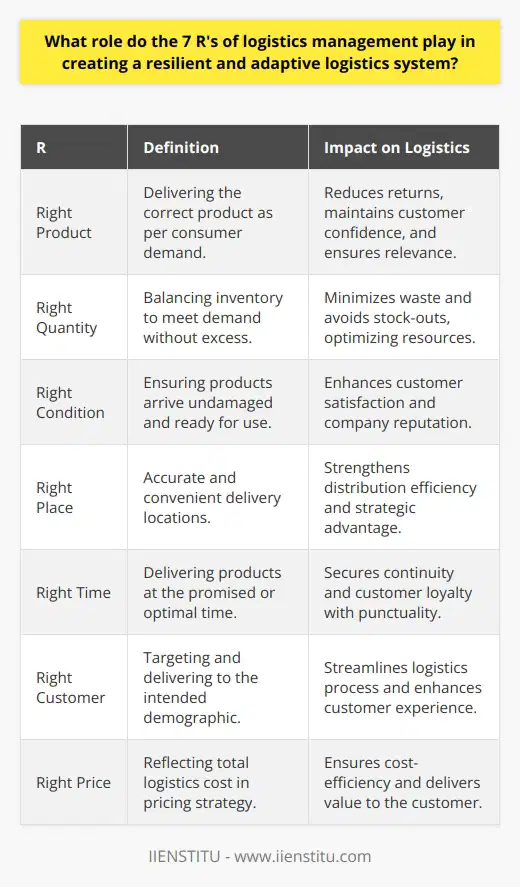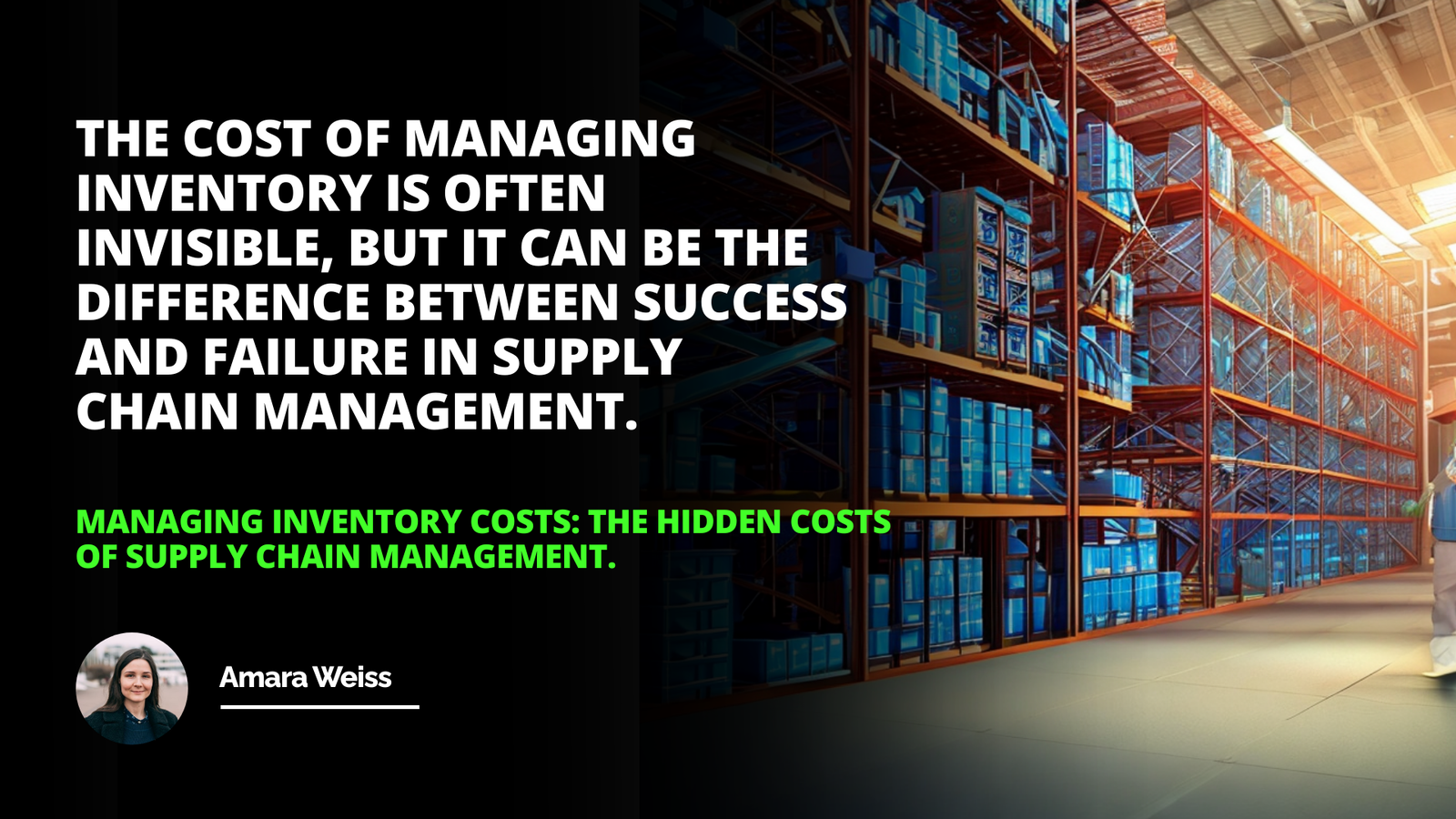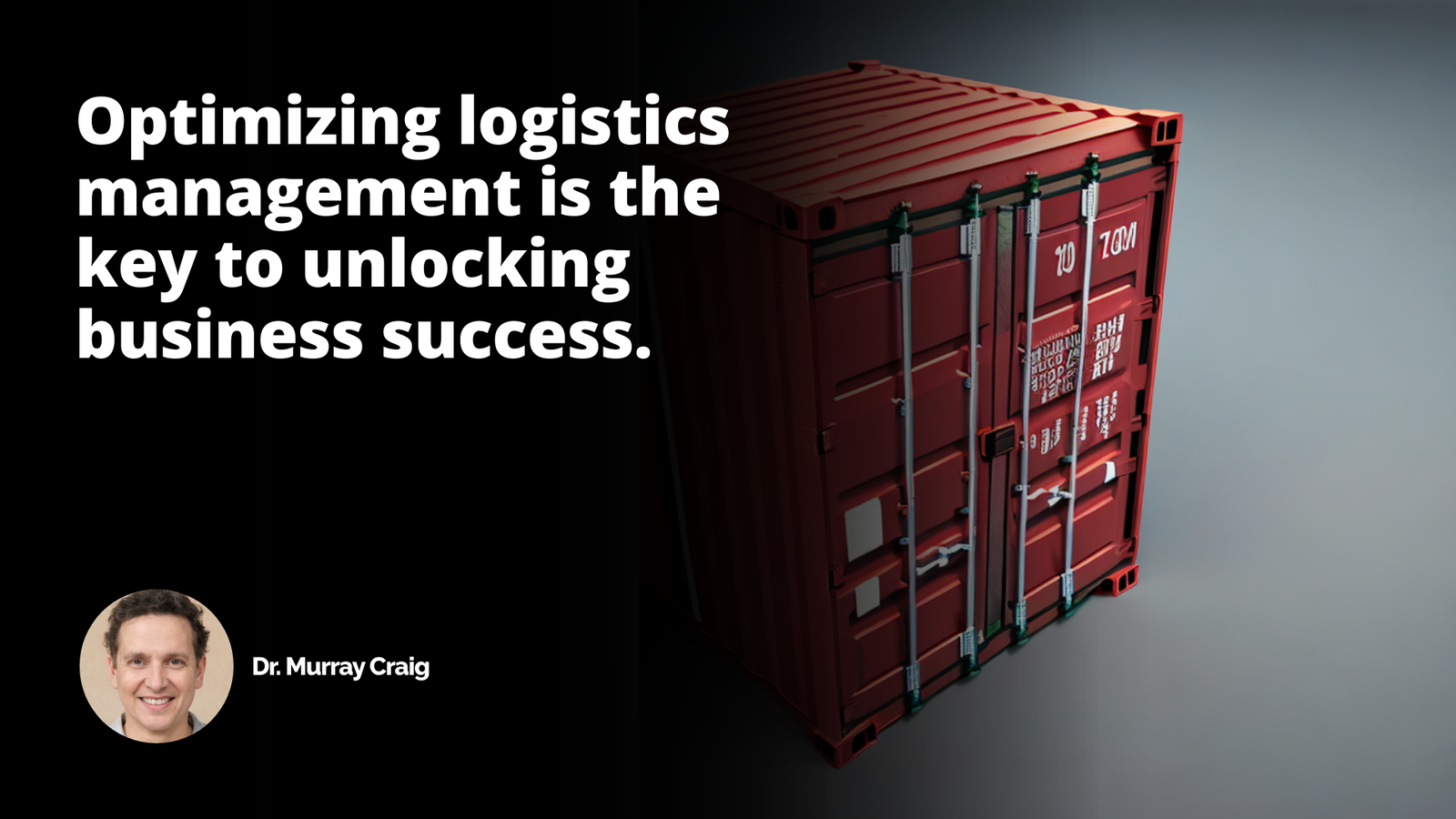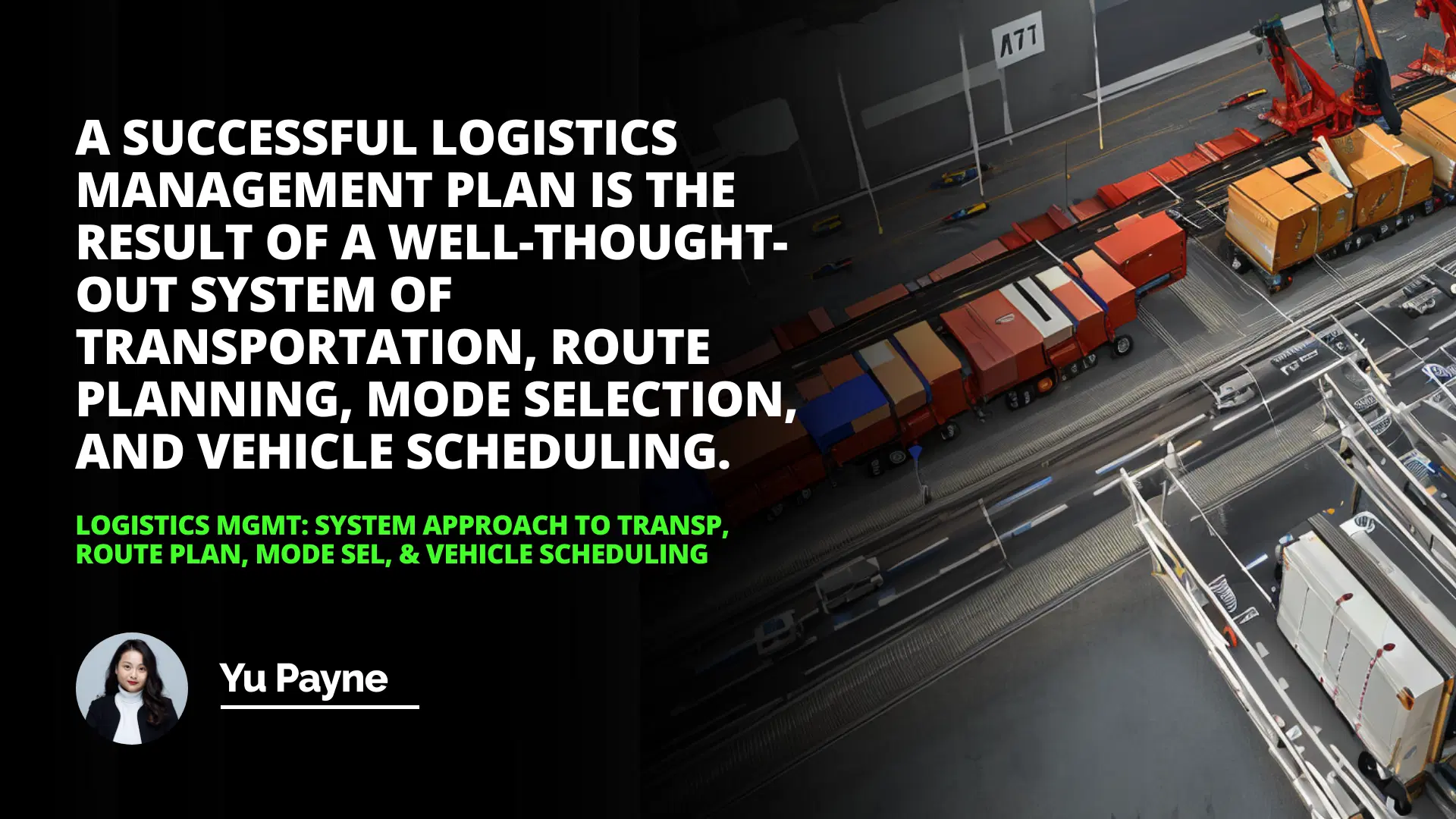
You know, I never really appreciated the complexity of logistics until I found myself managing a small family business a few years ago. It was a quaint little operation—a bakery, to be precise—tucked away in a cozy corner of our town. We prided ourselves on making the freshest bread and pastries. But as we grew, so did the challenges of getting our products from the oven to the customers’ tables efficiently. Suddenly, terms like supply chain, inventory management, and transportation logistics became part of my daily vocabulary.
Embracing the System Approach to Logistics Management
When I think about logistics, it's a bit like orchestrating a symphony. Each instrument, or in this case, each component of the supply chain, needs to play its part harmoniously to create a beautiful piece of music. The system approach to logistics management emphasizes this interconnectedness.
Introduction
System Approach to Logistics Management
Transportation
Route Planning
Mode Selection and Vehicle Scheduling
Initially, we struggled because we treated procurement, inventory, transportation, and customer service as separate entities. But once we started seeing them as parts of a whole, we could coordinate better. For instance, aligning our procurement schedules with inventory levels and delivery capacities ensured we didn't overstock or run out of essential ingredients.
This holistic view allowed us to:
Enhance Communication: Departments started sharing information more freely.
Reduce Costs: By synchronizing activities, we eliminated unnecessary expenses.
Improve Flexibility: We could respond faster to changes in demand or supply.
Increase Customer Satisfaction: Consistent service led to happier customers.
Transportation: Beyond Just Moving Goods
In the broader context, transportation logistics strategies aren't just about moving goods; they're about adding value to the product through availability. As Coyle, Novack, and Gibson highlight in their book, transportation impacts the economic value of goods by making them accessible when and where customers need them.
In larger organizations, transportation choices can be even more complex. Companies must decide between different modes:
Road Transport: Flexible and good for short distances.
Rail Transport: Cost-effective for bulk goods over long distances.
Air Transport: Fast but expensive; ideal for perishable or high-value items.
Sea Transport: Economical for international shipping but slower.
Pipeline Transport: Used for liquids and gases.
Mode Selection: Finding the Right Fit
I met a logistics manager named Sarah at a conference once. She worked for a multinational electronics company. She shared how they used a combination of air and sea freight to balance cost and speed. For new product launches, they used air transport to meet initial high demand quickly. For restocking, they relied on sea freight to reduce costs.
Factors influencing their mode selection included:
1- Urgency of Delivery: Tight deadlines necessitated faster modes.
2- Cost Constraints: Budget restrictions often dictated the use of cheaper transportation.
3- Product Characteristics: Fragile or perishable items required special handling.
4- Distance and Geography: Some regions had limited transportation options.
5- Environmental Impact: Increasingly, companies consider the carbon footprint of their transportation modes.
Vehicle Scheduling: Maximizing Efficiency
Choosing the right transportation mode is essential, but vehicle scheduling is where efficiency truly comes into play. For our bakery, efficient vehicle scheduling meant our vans were fully loaded and followed optimized routes. In Sarah's case, managing a fleet of trucks across different countries required sophisticated scheduling software.
Key aspects of effective vehicle scheduling include:
Load Optimization: Ensuring vehicles carry the maximum allowable load to reduce trips.
Timely Maintenance: Regular check-ups prevent breakdowns that can cause delays.
Driver Management: Assigning drivers based on routes and legal driving hour limits.
Compliance with Regulations: Adhering to transportation laws and safety standards.
A successful logistics management plan results from a well-thought-out transportation system, route planning, mode selection, and vehicle scheduling.
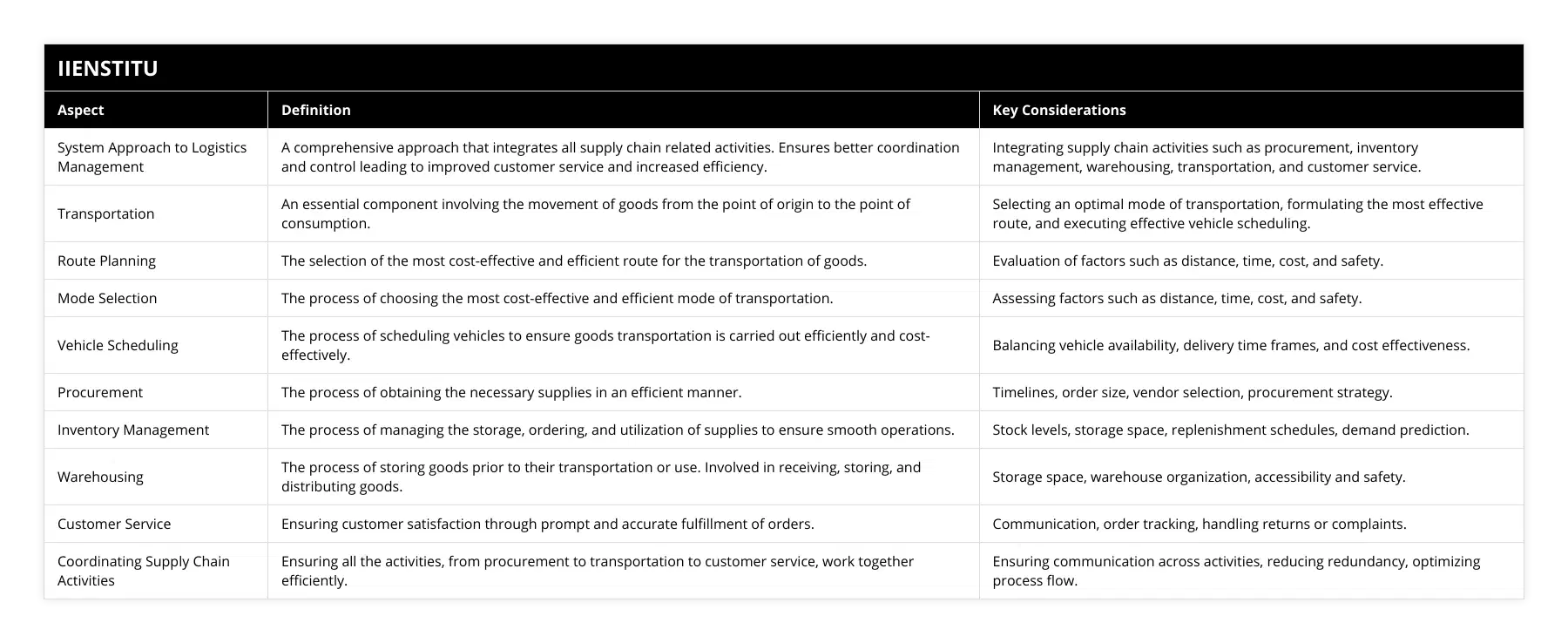
Real-Time Tracking: Using GPS and telematics to monitor vehicle locations and statuses.
The Art of Efficient Route Planning
Delving into efficient route planning methods was a game-changer for our business. I recall one particular incident when our delivery van got stuck in traffic, causing delays that left our customers disappointed. That's when I delved into route planning. We started considering factors like traffic patterns, road conditions, and delivery time windows. By optimizing our routes, we not only saved time but also reduced fuel costs—a win-win situation!
Here are some strategies we adopted:
1- Analyzing Delivery Destinations: We grouped deliveries based on geographical proximity.
2- Utilizing GPS Technology: Real-time updates helped us avoid traffic snarls.
3- Planning Off-Peak Deliveries: Whenever possible, we scheduled deliveries during off-peak hours.
4- Regularly Updating Routes: We kept our routes flexible to adapt to unforeseen circumstances.
5- Feedback from Drivers: Our drivers provided valuable insights into road conditions and potential shortcuts.
Integrating Supply Chain Components
Implementing supply chain integration techniques helped us streamline operations. By having a cohesive plan, every part of the supply chain worked towards common goals, reducing inefficiencies.
The transformation didn't stop there. We started integrating other supply chain components:
Procurement: By building strong relationships with our suppliers, we ensured timely delivery of fresh ingredients.
Inventory Management: Implementing an inventory system helped us track stock levels and reduce waste.
Warehousing: Though our storage was limited, optimizing the space improved accessibility and efficiency.
Customer Service: Keeping our customers informed about delivery statuses enhanced their satisfaction.
Challenges in Logistics Management
Despite our best efforts, challenges abound in logistics. Understanding logistics management challenges and solutions is crucial for any business. Some common issues are:
Unexpected Delays: Traffic jams, accidents, or bad weather can disrupt schedules.
Supply Chain Disruptions: Supplier failures or raw material shortages affect production.
Regulatory Changes: New laws can require adjustments in transportation practices.
Technological Changes: Keeping up with the latest advancements requires investment.
Cost Fluctuations: Fuel price changes can significantly impact transportation costs.
Strategies to Overcome Logistics Challenges
To tackle these challenges, businesses can:
1- Develop Contingency Plans: Having backup routes or alternative suppliers.
2- Invest in Technology: Use advanced software for better forecasting and planning.
3- Enhance Communication: Share information promptly among all stakeholders.
4- Train Staff: Equip employees with the skills to handle unexpected situations.
5- Monitor Performance: Regularly assess logistics operations to identify improvement areas.
The Human Element in Logistics
At the heart of logistics are the people who make it all happen. From drivers to warehouse staff, their roles are crucial. I remember when we started involving our delivery team in planning meetings. Their firsthand insights helped us improve our processes significantly.
One of our drivers, Mike, suggested adjusting delivery times to avoid school zones during peak hours. This simple change reduced delays and made his job easier. Listening to the team made a huge difference.
Sustainability in Logistics
Modern logistics also focuses on sustainability. Companies are seeking ways to reduce their environmental impact. Strategies include:
Using Electric Vehicles: Reduces emissions in urban deliveries.
Optimizing Routes: Less fuel consumption means lower carbon footprint.
Green Packaging: Minimizing waste with eco-friendly materials.
Collaborative Logistics: Sharing transportation resources with other companies.
Reassignment and Adaptability
In logistics, adaptability is key. Similar to drafting a reassignment request letter, knowing the tips and information on how to effectively reassign resources can make a significant difference. Whether it's reallocating drivers or changing delivery schedules, being prepared to adjust plans is essential for maintaining smooth operations.
I recall a time when one of our drivers fell ill unexpectedly. We had to reassign tasks quickly to ensure deliveries weren't affected. It reminded me of how essential it is to have contingency plans and be adaptable.
The Role of Technology in Logistics Management
Technology played a pivotal role in our logistics overhaul. Embracing technology in logistics management is no longer optional but necessary for staying competitive. We utilized software for route optimization, inventory tracking, and even customer communication. These tools made the complex processes more manageable and provided data-driven insights.
Some technological tools we adopted were:
Route Optimization Software: Helped us find the most efficient delivery paths.
Inventory Management Systems: Kept track of stock levels in real-time.
Customer Relationship Management (CRM): Enhanced our engagement with customers.
Telematics Devices: Monitored vehicle performance and driver behavior.
Automated Alerts: Notified us of any delays or issues promptly.
Companies investing in these technologies are likely to see benefits such as:
Increased Efficiency: Automation reduces manual errors and speeds up processes.
Better Decision-Making: Analytics provide insights for strategic planning.
Enhanced Transparency: Customers can track their orders in real-time.
Improved Security: Data encryption and secure networks protect sensitive information.
The Future of Logistics Management
Looking ahead, technologies like Artificial Intelligence (AI) and Internet of Things (IoT) are set to revolutionize logistics. AI can enhance route planning by predicting traffic patterns, while IoT devices can provide real-time tracking of goods.
Blockchain technology is another promising development, offering secure and transparent tracking of products through the supply chain.
Conclusion
The journey into logistics management taught me that success lies in seeing the bigger picture and paying attention to the details. Whether you're running a small bakery or managing logistics for a multinational corporation, the principles remain the same.
By adopting the system approach, focusing on efficient transportation, carefully planning routes, selecting appropriate transportation modes, and scheduling vehicles effectively, you can overcome challenges and deliver exceptional value to your customers.
Remember, logistics isn't just about moving things; it's about moving them better.
References
1- Christopher, M. (2016). Logistics and Supply Chain Management (5th ed.). Pearson Education Limited.
2- Rushton, A., Croucher, P., & Baker, P. (2017). The Handbook of Logistics and Distribution Management (6th ed.). Kogan Page.
3- Chopra, S., & Meindl, P. (2019). Supply Chain Management: Strategy, Planning, and Operation (7th ed.). Pearson.
4- Novack, R. A., Gibson, B., & Coyle, J. J. (2019). Transportation: A Global Supply Chain Perspective (9th ed.). Cengage Learning.
5- Coyle, J. J., Novack, R. A., Gibson, B. J., & Bardi, E. J. (2015). Transportation: A Supply Chain Perspective (8th ed.). South-Western Cengage Learning.
Frequently Asked Questions
What are the benefits of using a system approach to logistics management?
Logistics management is an essential component of any business. It involves the planning and execution of the transportation, storage, and handling of goods, materials, and services. Using a systematic approach to logistics management can provide numerous benefits to organizations.
First, a system approach to logistics management can help to reduce costs. Organizations can identify areas where costs can be reduced by using a comprehensive system, such as warehousing and transportation costs. Additionally, a systematic approach can help to improve efficiency by streamlining processes and improving communication between departments. This can lead to improved customer service and faster deliveries.
Second, a logistics management system approach can help improve customer satisfaction. Organizations can ensure that their interests are delivered on time and in good condition by utilizing a system to manage the transportation and storage of goods. Additionally, a systematic approach can help to reduce the risks associated with logistics management, such as the loss or damage of goods. This can lead to improved customer satisfaction and a better overall customer experience.
Third, a system approach to logistics management can help to improve the quality of goods and services. Organizations can ensure that their interests are of the highest quality by using a system to manage the transportation, storage, and handling of goods. Additionally, a systematic approach can help to ensure that goods are delivered promptly. This can lead to improved customer satisfaction and a better overall customer experience.
Finally, a system approach to logistics management can help improve the organization's overall efficiency. Organizations can reduce the amount of time and resources spent on logistics management by utilizing a system to manage the transportation, storage, and handling of goods. This can lead to improved efficiency and better overall performance.
In conclusion, using a system approach to logistics management can provide numerous benefits to organizations. A system approach can help reduce costs, improve efficiency, and improve customer satisfaction and the quality of goods and services. Additionally, a systematic approach can help improve the organization's overall efficiency. For these reasons, the use of a system approach to logistics management should be strongly considered by organizations.
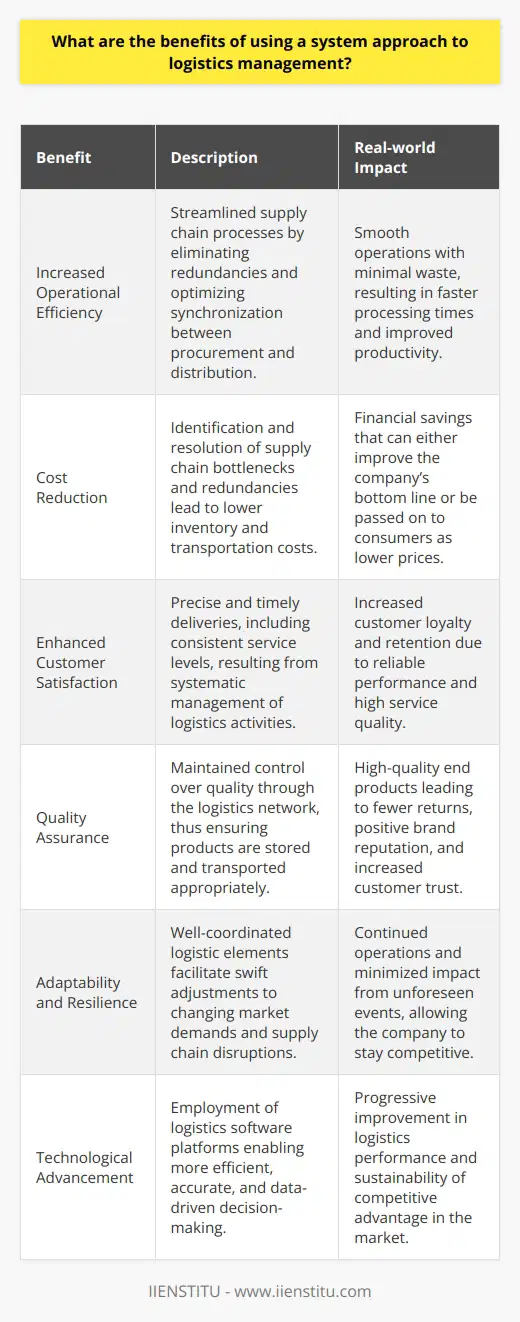
How does route planning help optimize transportation costs?
Route planning is an essential factor in optimizing transportation costs. It involves using algorithms to analyze the best routes for delivery vehicles, which can result in significant cost savings and improved customer satisfaction.
Route planning allows for more efficient use of transportation resources by minimizing wasted travel. This can be achieved by finding the most cost-effective delivery routes with the least travel time. Systematic planning helps reduce fuel costs and wear and tear on vehicles by optimizing the number of stops and minimizing unplanned deviations. In addition, route planning can help reduce the number of personnel required to complete the delivery, which further reduces costs.
The route planning also helps to improve customer satisfaction by providing reliable delivery times and accurate route information. By considering traffic patterns, road conditions, and other factors such as weather, route planning algorithms can adjust the route to ensure timely deliveries. In addition, route planning can provide customers with up-to-date information on the estimated arrival time of their deliveries.
Route planning can also help to improve safety by avoiding congested roads and other hazardous situations. By utilizing route planning algorithms, delivery vehicles can be routed around dangerous areas, reducing the risk of collisions and other accidents. In addition, route planning algorithms can monitor driver behavior and suggest alternate routes when needed.
Overall, route planning can help optimize transportation costs by minimizing wasted travel, reducing personnel costs, improving customer satisfaction, and improving safety. By utilizing route planning algorithms, transportation companies can improve the efficiency of their operations and reduce transportation costs.
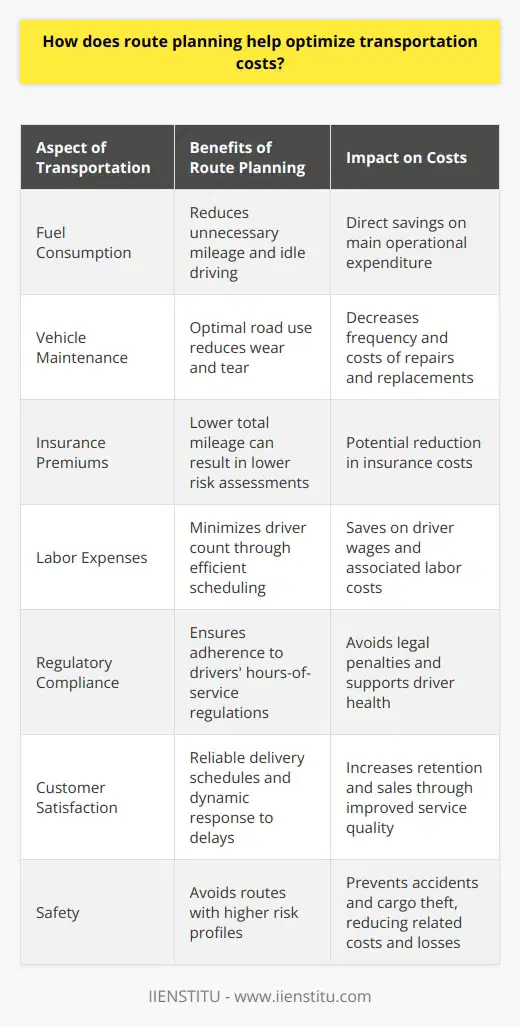
What factors should be considered when selecting a mode of transportation and scheduling vehicles?
When selecting a mode of transportation and scheduling vehicles, several factors must be considered to ensure efficient and safe operations.
First, the environment must be considered when considering the type of transportation to use. For example, a four-wheel-drive or all-terrain vehicle may be the most appropriate if the route involves traversing rugged terrain. Additionally, the availability of public transportation should be assessed, as this may offer the most cost-effective and convenient solution.
Next, the capacity of the vehicle must be considered. If transportation is to be used to transport many people, then a larger vehicle, such as a bus, maybe the most suitable choice. A truck may be the more suitable choice if the ride is to transport cargo.
The safety of the passengers must also be taken into account. When scheduling vehicles, it is essential to ensure that the cars are well-maintained and roadworthy. It is also vital to ensure that the drivers are adequately trained and licensed.
In addition, the cost of transportation should be taken into account. The cost of fuel, maintenance, and insurance should all be considered when deciding. Furthermore, the cost of public transportation should be evaluated to determine whether this is the most cost-effective option.
Finally, the time of day should be taken into account. If the vehicle is to be used during peak hours, then additional planning is required to ensure that the vehicle is available at the time necessary. Additionally, planning for any potential traffic delays is essential to ensure the schedule is kept.
In conclusion, when selecting a mode of transportation and scheduling vehicles, several factors must be considered to ensure efficient and safe operations. These factors include the environment, capacity, safety, cost, and time of day. Considering these factors, it is possible to select the most appropriate mode of transportation and schedule vehicles accordingly.
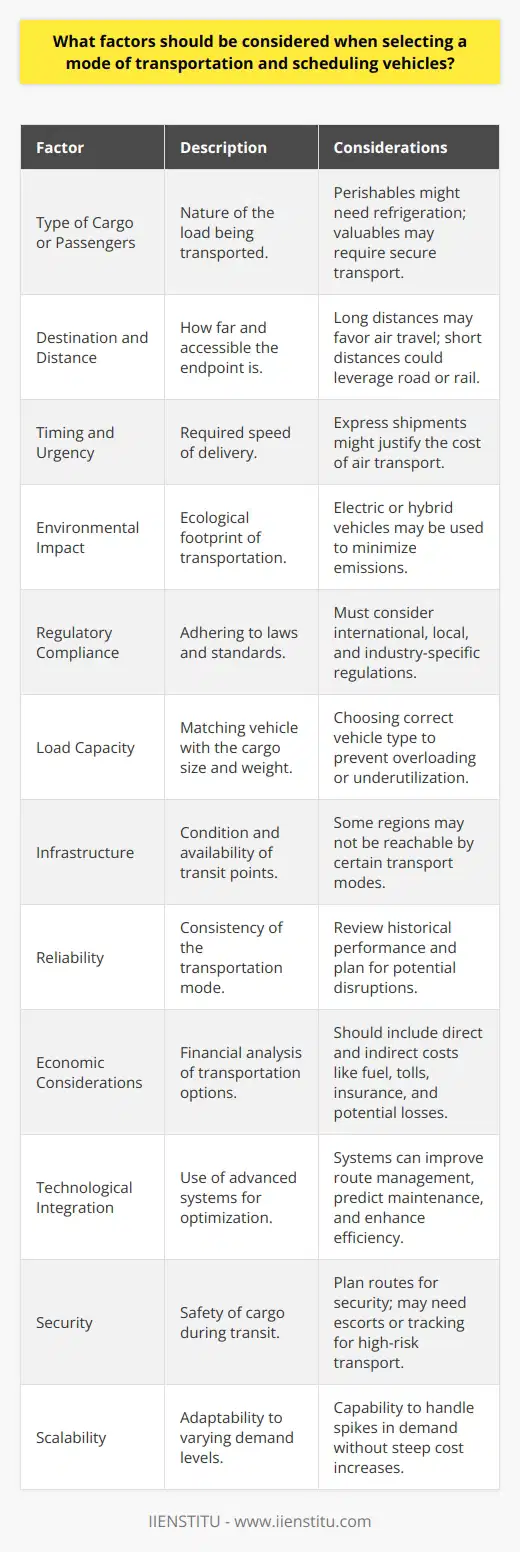
What is the systems approach to logistics management?
Understanding Systems Approach
The systems approach to logistics management examines the entire supply chain as a holistic entity, recognizing the interdependencies among its components. This method acknowledges the complex interplay of various elements within the supply chain, and how they influence one another.
Key Elements in Systems Approach
Several key elements are essential to this approach, including inventory management, transportation, warehousing, and the flow of material and information. The focus is on optimizing the entire supply chain rather than isolated segments, ensuring a comprehensively efficient ecosystem rather than merely independent functions.
Importance of Interconnectivity
Embracing interconnectivity is vital to the systems approach. It requires effective communication and collaboration between various stakeholders such as suppliers, manufacturers, distributors, and retailers. In doing so, this approach allows for the identification of inefficiencies and bottlenecks, leading to improvements in overall performance.
Role of Modern Technology
Modern technology has played a crucial role in enabling effective systems approach logistics management. Innovative tools, like enterprise resource planning (ERP) software and the Internet of Things (IoT), facilitate seamless real-time data sharing and synchronization, making it easier for stakeholders to monitor the supply chain as a cohesive unit.
Integration and Flexibility
A successful systems approach hinges upon the integration of distinct supply chain elements and flexibility to adapt to changing dynamics. With integrated systems in place, managers can quickly respond to changes in demand, unpredictable events, and unforeseen disruptions, leading to a resilient and nimble logistics system.
In conclusion, the systems approach to logistics management aims to optimize the supply chain through a holistic lens, emphasizing collaboration, integration, and flexibility. By adopting this method, businesses can streamline their logistics, cut costs, and become more competitive in today's fast-paced and demanding market landscape.
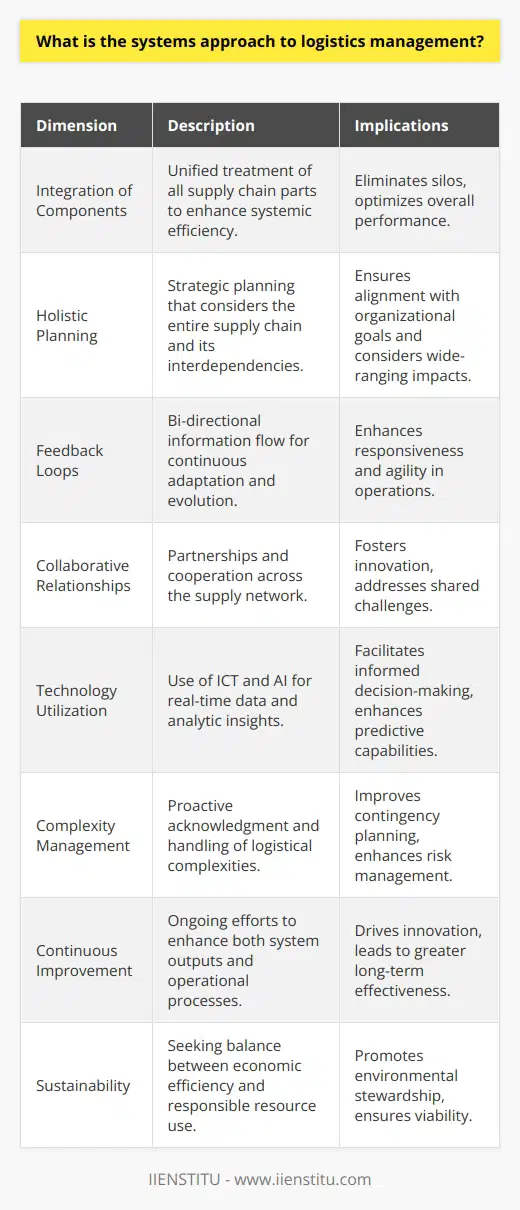
What are the 7 R's of logistics management?
Seven Key Components of Logistics Management
Effective logistics management relies on the implementation of the 7 R's: right product, right customer, right quantity, right condition, right place, right time, and right cost. These principles are essential for ensuring that products reach their intended destination in a cost-effective and efficient manner, maximizing customer satisfaction and minimizing the use of resources.
Right Product and Right Customer
The first step in logistics management is determining the right product to be delivered to the right customer. This involves understanding customer needs, preferences, and demands in order to accurately fulfill their requirements, ensuring the correct goods are sent to the appropriate recipient.
Right Quantity and Right Condition
The third and fourth R's involve determining the appropriate quantity of the product and ensuring that it is in the right condition when it arrives at its destination. Accuracy in quantity is crucial for meeting customer demands and avoiding excess inventory or stockouts. Maintaining the right condition is essential for preserving the quality, safety, and usability of the product during transit.
Right Place and Right Time
A critical aspect of logistics management is ensuring that goods are delivered to the right place at the right time. Meeting deadlines and providing timely delivery are essential for optimizing supply chain efficiency and meeting customer expectations for punctual delivery. Effective transportation planning and route optimization play a key role in achieving these goals.
Right Cost
Lastly, achieving the right cost involves optimizing logistics activities to minimize expenses and maximize value for both the company and the customer. This involves considering factors such as transportation costs, warehousing and storage expenses, and inventory management. Streamlining these aspects of logistics management provides companies with a competitive advantage in the marketplace while simultaneously improving customer satisfaction.
In conclusion, the 7 R's of logistics management are essential for streamlining the overall supply chain process, reducing costs, and ensuring customer satisfaction. By implementing these principles, companies can effectively enhance their logistics operations and achieve success in a competitive market.
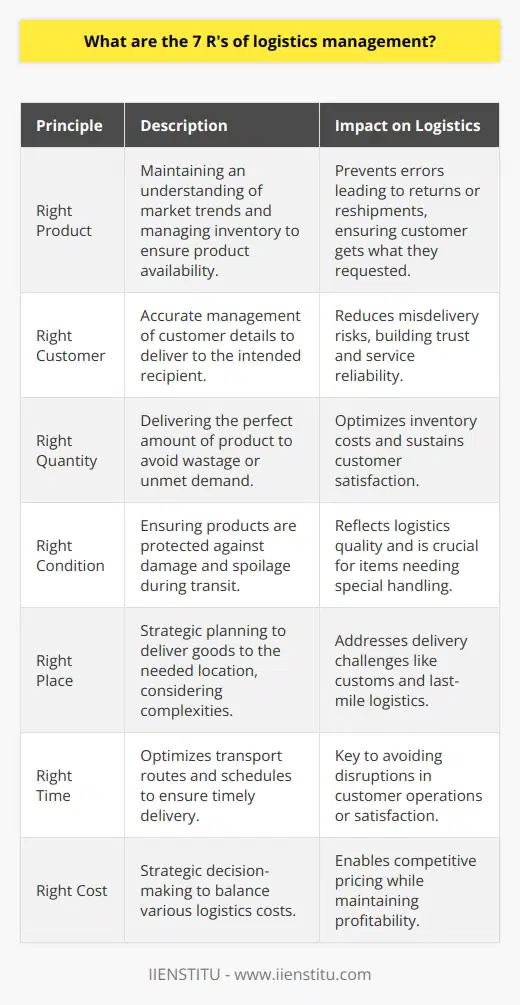
What are the 3 main activities of logistics systems?
Three Main Activities of Logistics Systems
Supply Chain Management
The first main activity that logistics systems engage in is supply chain management. This involves the coordination of various stages of a product's life, from the procurement of raw materials to the manufacturing of the final product, as well as distribution to end users. Effective supply chain management is essential for businesses, as it optimizes the flow of products and information, ultimately reducing costs and increasing productivity.
Warehousing and Storage
Another crucial aspect of logistics systems is warehousing and storage. This refers to the efficient management of inventory, which includes the physical storage of goods and the monitoring of stock levels. A well-organized warehousing system enables companies to meet customer demands in a timely and accurate manner, while also minimizing storage costs. Furthermore, adequate warehousing and storage can play a significant role in the preservation and protection of goods, ensuring that products remain in optimal condition until they are delivered to the end user.
Transportation and Delivery
The final main activity of logistics systems is transportation and delivery. This encompasses the movement of products between various points in the supply chain, including transportation from the manufacturer to the warehouse or distribution center, as well as the delivery of products to customers. Efficient transportation and delivery not only ensure timely arrival of goods, but also play a significant role in reducing carbon emissions and maximizing the cost-effectiveness of logistics operations. For transportation and delivery to be effective, companies must select appropriate methods and routes, as well as continuously monitor and adapt to external factors such as fuel costs, weather conditions, and regulatory requirements.
In conclusion, logistics systems encompass a wide range of activities that are critical for businesses to operate effectively and competitively. The main activities of supply chain management, warehousing and storage, and transportation and delivery play crucial roles in optimizing the flow of products and information, ultimately leading to a more successful and efficient business operation.
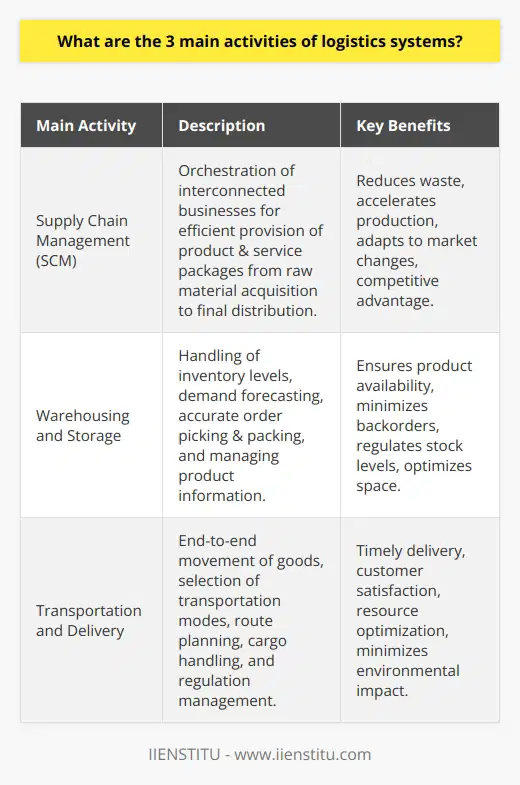
What is the difference between traditional logistics management and the systems approach to logistics management?
Traditional Logistics Management
Traditional logistics management primarily focuses on the efficient movement of goods from the point of origin to the point of consumption. This approach considers separate functional areas such as transportation, warehousing, inventory control, and order processing, with an emphasis on cost reduction and resource optimization. The main objective is to achieve short-term operational goals, limiting its scope to tactical and operational concerns within a firm's supply chain.
Systems Approach to Logistics Management
On the other hand, the systems approach to logistics management broadens the perspective by considering the entire supply chain as an integrated system. This viewpoint acknowledges the interconnectedness of various parties, such as suppliers, manufacturers, distributors, retailers, and customers, involved in the production and delivery of goods. The systems approach seeks to optimize the overall performance of the supply chain, rather than focusing solely on individual components.
Integration and Coordination
The major difference between traditional logistics management and the systems approach lies in the level of integration and coordination among the various supply chain entities. The systems approach promotes a more holistic view, encouraging collaboration and information-sharing among stakeholders, while traditional logistics management remains siloed in its approach. This enhanced communication leads to enhanced efficiency, improved service levels, and increased responsiveness to market changes.
Strategic Alignment
Another key distinction between the two approaches is the emphasis on strategic alignment in the systems approach. While traditional logistics management largely deals with tactical decisions, the systems approach stresses the importance of aligning logistics operations with the overall business strategy. This includes considering long-term objectives, risk management, and maintaining a competitive advantage in a dynamic market environment.
Performance Measurement
The systems approach also differs from traditional logistics management in its emphasis on using performance measurement and feedback mechanisms to continuously evaluate and improve supply chain operations. It identifies key performance indicators (KPIs) to monitor and adjust the system, driving continuous improvement and ensuring alignment with strategic goals. In contrast, traditional logistics management may rely more on intuitive decision-making and experience, lacking a structured feedback system for improvement.
In conclusion, traditional logistics management focuses on individual functional areas within the supply chain, seeking cost reduction and resource optimization. Conversely, the systems approach to logistics management embraces the interconnectedness of supply chain entities, promoting collaboration, strategic alignment, and continuous improvement for the overall benefit of organizations and their stakeholders.
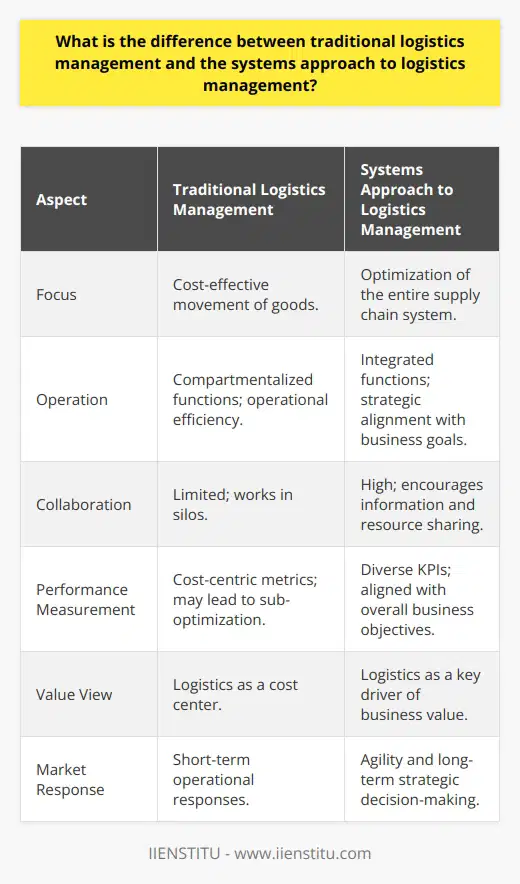
How do the 7 R's of logistics management contribute to overall supply chain efficiency?
The Role of the 7 R's in Supply Chain Efficiency
Understanding the 7 R's of logistics management is crucial to optimizing supply chain efficiency. These seven principles – right product, right quantity, right condition, right place, right time, right source, and right price – serve as guidelines for achieving maximum effectiveness and cost savings in logistics operations.
Right Product and Right Source
Focusing on these elements ensures that the correct items are acquired from the most suitable suppliers, minimizing the risk of procuring substandard goods or dealing with unreliable vendors. This in turn, enhances product quality, customer satisfaction, and the company's reputation.
Right Quantity and Right Condition
By delivering the appropriate amount of goods in the best possible quality, waste and excess inventory are reduced. This leads to lower storage costs, more accurate forecasting, and improved cash flow by avoiding overstocking or stockouts.
Right Time and Right Place
Timely and accurate delivery of products is essential for meeting customer expectations and avoiding delays in the supply chain. Ensuring goods arrive at their intended destination at the proper time reduces lead times, increases customer satisfaction, and strengthens supplier-customer relationships.
Right Price
Finally, negotiating the optimal price for products and services ensures that both the purchasing company and the supplier achieve a profitable and sustainable relationship. Balancing cost and value establishes a competitive advantage, improves profitability, and contributes to overall supply chain efficiency.
In conclusion, the 7 R's of logistics management act as a comprehensive framework for optimizing supply chain operations. By adhering to these principles, companies can enhance efficiency, reduce costs, and ultimately achieve a competitive edge in their respective markets.
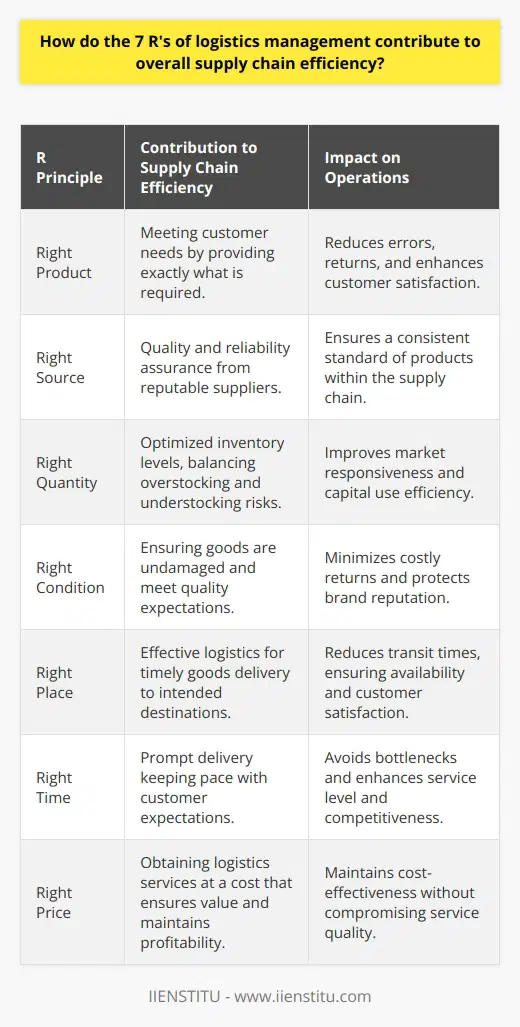
In what ways do the three main activities of logistics systems influence the overall performance of a supply chain?
Impact on Supply Chain Efficiency
Logistics systems play a crucial role in influencing the overall performance of a supply chain. The three primary activities include transportation, warehousing, and inventory management. These activities directly impact the efficiency, cost-effectiveness, and overall responsiveness of the supply chain management process.
Transportation: Speed and Reliability
Firstly, transportation creates a significant impact on a supply chain's performance by providing a swift and reliable movement of goods between different locations. Efficient transportation positively affects delivery times, reduces the risk of delays, and ensures that products arrive at the correct destination on time. An optimized transportation system not only enhances customer satisfaction but also helps maintain a competitive advantage in the global marketplace.
Warehousing: Storage and Distribution
Secondly, warehousing contributes to the overall performance of a supply chain by offering adequate storage and efficient distribution of goods. This is critical to avoid stockouts or overstocks, which can lead to excessive costs or missed sales opportunities. Proper warehousing techniques also allow companies to store and distribute products based on their specific needs, such as temperature or security requirements. Consequently, a well-organized warehousing system can reduce the total cost of ownership while maintaining high levels of customer service.
Inventory Management: Accuracy and Responsiveness
Lastly, inventory management influences the overall supply chain performance by ensuring the right products are available at the right time and in the right quantities. Accurate inventory control helps companies respond quickly to customer demands while reducing inventory costs, such as carrying and holding costs. Effective inventory management strategies, such as just-in-time, and the use of technology, like RFID tagging, help improve supply chain visibility, forecasting, and decision-making processes.
In conclusion, the three main activities of logistics systems – transportation, warehousing, and inventory management – considerably influence the overall performance of a supply chain. Implementing effective strategies for these activities can lead to higher efficiency, cost savings, and better customer service, ultimately enhancing the overall value and competitiveness of the supply chain.
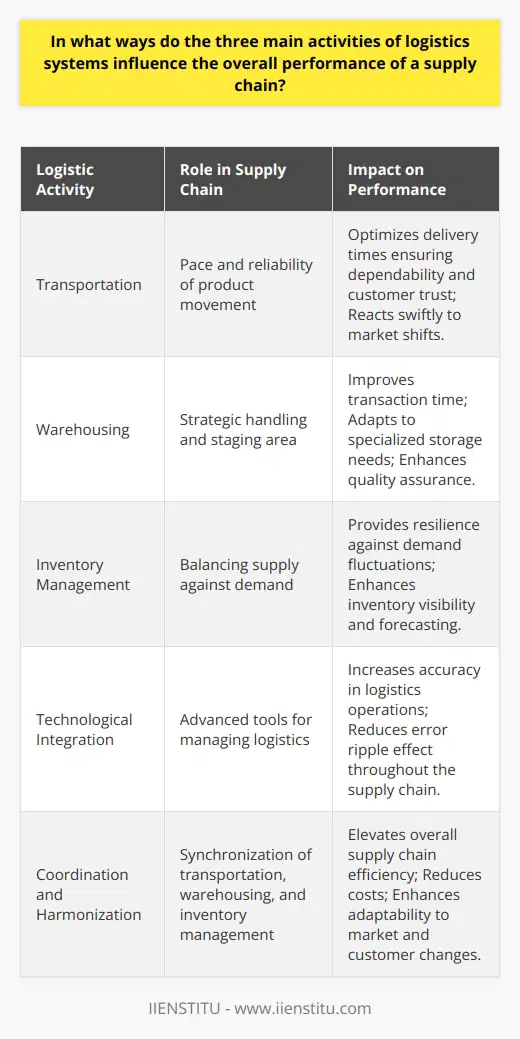
What is the systems approach in logistics management?
Understanding the Systems Approach
In logistics management, the systems approach is a holistic method that combines various aspects of the supply chain to create efficiencies and ensure seamless operations. By evaluating individual elements as interconnected components of a larger system, logistics managers can design effective strategies to optimize resources, streamline processes, and minimize costs.
Key Components of the System
The logistics system comprises several key components, including procurement, inventory, warehousing, transportation, and information management. By coordinating these components, managers can identify potential bottlenecks or challenges and develop innovative solutions to address them.
Procurement and Inventory Management
For a system to be effective, the procurement process must be closely aligned with inventory management. This involves analyzing historical demand patterns, forecasting future needs, and establishing optimal order quantities for each product to minimize stockouts, reduce inventory holding costs, and improve cash flow.
Warehousing and Transportation
Efficient warehousing and transportation strategies are critical for a successful logistics system. Utilizing strategic locations for warehouses, implementing effective storage techniques, and deploying the most suitable modes of transport can minimize lead times, reduce handling costs, and improve overall service levels.
Information Management and Integration
In a systems approach, data and information are integral to effective decision-making. Leveraging advances in technology, such as the Internet of Things (IoT), sensors, and data analytics, can enable real-time tracking, monitoring, and analysis of the system's performance. This can lead to proactive problem-solving and continuous improvement across the entire logistics system.
Benefits of the Systems Approach
Embracing the systems approach in logistics management offers several advantages. First, it encourages a comprehensive understanding of the entire supply chain, allowing managers to recognize the interdependencies between various components. Second, this approach leads to better alignment and synchronization of resources, preventing wastes and redundancies. Finally, the systems approach fosters a culture of continuous improvement, as the system is regularly assessed and updated to reflect changing market conditions, customer demands, and technological advancements.
In conclusion, the systems approach is a valuable tool for logistics management, enabling organizations to optimize their supply chain operations, reduce costs, and deliver superior customer service. By focusing on the interconnectedness of various components, logistics managers can develop and implement holistic strategies for long-term success.
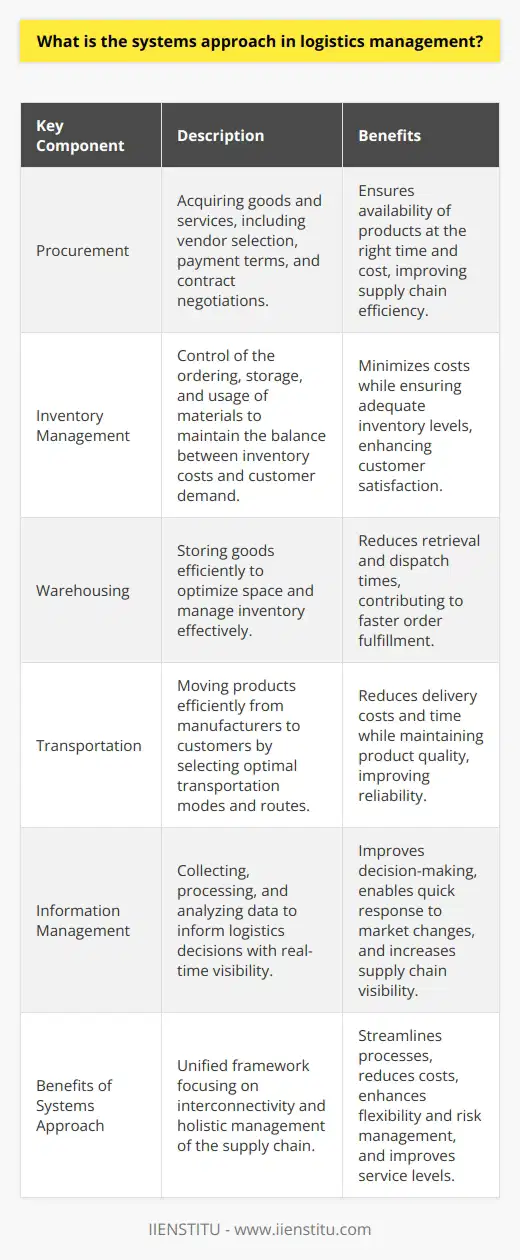
What is routing and scheduling in logistics?
Routing in Logistics
Routing refers to the process of determining the most efficient and cost-effective path for the transportation of goods from the point of origin to the point of consumption. In logistics, routing is essential for minimizing transportation costs, reducing transit time, optimizing resource utilization, and ensuring timely delivery of products to the customers. Transportation managers often use sophisticated routing algorithms and software tools to select the best routes, considering factors such as distance, traffic conditions, and transport infrastructure.
Scheduling in Logistics
Scheduling involves the organization of transportation activities and the allocation of resources, including vehicles, drivers, and equipment, to ensure timely and efficient delivery of goods. In logistics, scheduling is crucial for maintaining a smooth flow of materials throughout the supply chain, reducing the risk of stock-outs or surplus inventory, and meeting customer demands. Additionally, scheduling helps coordinate the activities of different carriers, warehouses, and distribution centers, thereby increasing the overall efficiency of logistics operations.
Key Factors in Routing and Scheduling
Several factors influence the effectiveness of routing and scheduling in logistics. These factors include:
Distance and Time: Minimizing the distance and time between the points is critical for reducing transportation costs and ensuring timely deliveries.
Traffic and Road Conditions: Real-time analysis of traffic and road conditions can help identify potential bottlenecks and select alternative routes, thereby improving efficiency.
Load Capacity: Effective routing and scheduling require considering the load capacities of vehicles, ensuring optimal utilization of resources.
Customer Requirements: Timely deliveries, product availability, and meeting delivery windows are essential for satisfying customer needs; hence, effective routing and scheduling must consider these aspects.
Regulations and Restrictions: Adhering to transportation regulations, such as driving hours and load limits, is crucial for avoiding fines and penalties, which can be factored into routing and scheduling decisions.
Carrier Coordination: Coordinating the activities of different carriers, vehicles, and equipment is crucial for maintaining a seamless flow of goods, reducing costs, and minimizing disruptions.
Conclusion
In conclusion, routing and scheduling are critical aspects of logistics that contribute to efficient transportation, optimal resource utilization, and enhanced customer satisfaction. By carefully considering factors such as distance, time, traffic conditions, and customer requirements, logistics managers can make informed routing and scheduling decisions that ultimately lead to successful supply chain management.
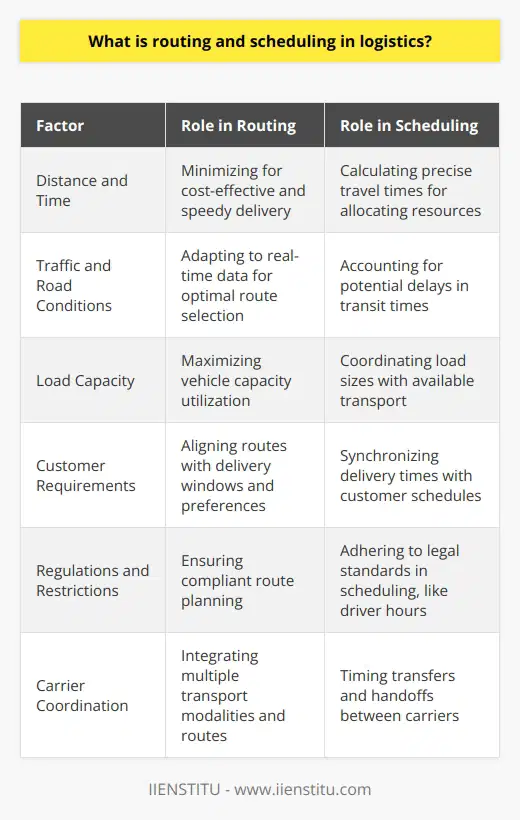
What is the systems approach in supply chain management?
Understanding Systems Approach in Supply Chain Management
The systems approach in supply chain management involves an integrative perspective of the entire supply chain network. The main goal is to enhance the overall performance and efficiency of the system by examining all elements and their interactions. This strategy is based on the principle of overall optimization, rather than on the basis of single components.
Key Dimensions of Systems Approach
Holistic Perspective: The systems approach emphasizes the interconnectedness of different components within the supply chain. It proposes that supply chain performance can only be improved if all elements are considered and analyzed in relation to one another.
Inter-organizational cooperation: This approach encourages organizations to actively collaborate with other players in the supply chain. This includes exchanging information, resources, and aligning goals for mutual benefit.
Systems Thinking: It involves the use of techniques and tools that enable a comprehensive understanding of the supply chain. Such methods include systems models, mapping, and analysis, which help uncover patterns and relationships among system entities.
Adaptive and Agile: A significant aspect of the systems approach is its emphasis on the need for adaptability and agility. Due to the constantly changing dynamics of the supply chain environment, organizations must proactively respond to disruptions and continuously improve their operations.
Applying the Systems Approach in Practice
The implementation of the systems approach in supply chain management calls for reevaluating traditional practices in order to achieve a more efficient and effective overall system. Some of the strategies that organizations can adopt include:
Enhancing information sharing: Companies should create integrated information systems that connect all supply chain partners, allowing real-time sharing of data and facilitating better decision-making processes.
Aligning performance metrics: Organizations should develop shared performance indicators that reflect the overall operational efficiency of the supply chain. By aligning individual goals with a common objective, partners can collaboratively work towards improving the system.
Fostering continuous improvement: Embedding a culture of continuous improvement across the supply chain enables organizations to enhance their efficiency and adaptability. Establishing practices such as benchmarking, Best Practices Among Leader method, and process-oriented learning can contribute to this end.
In conclusion, adopting the systems approach in supply chain management offers organizations the opportunity to understand and improve the interactions among supply chain components. By taking a holistic point of view and promoting inter-organizational cooperation, companies can enhance their supply chain efficiency and resilience.
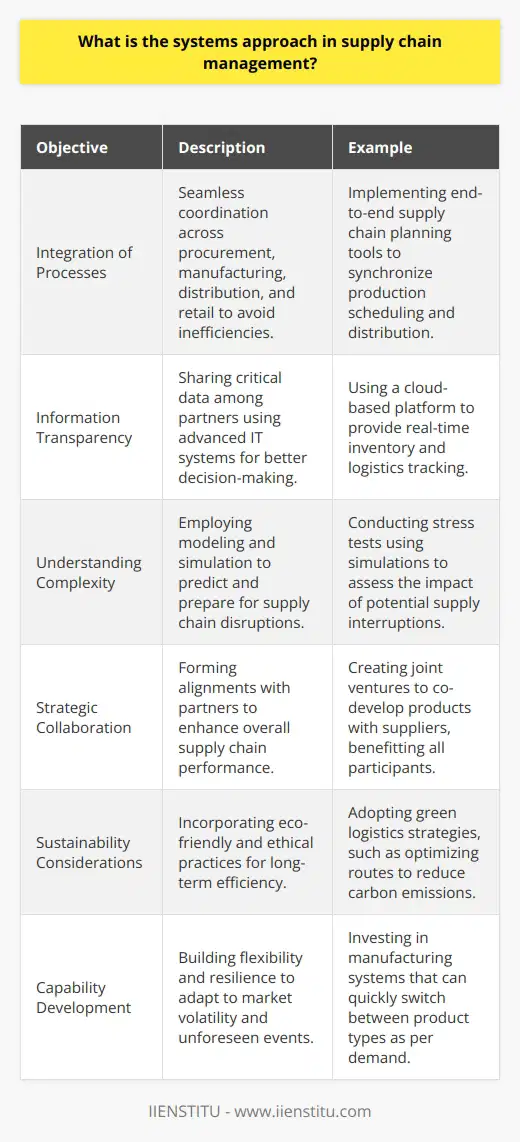
What is the role of technology in facilitating the system approach to logistics management?
Role of Technology in Logistics Management
Enhancing Integration and Coordination
The role of technology in facilitating the system approach to logistics management lies in its ability to enhance integration and coordination of various processes involved in supply chain management. By eliminating information silos, technology enables organizations to develop a comprehensive understanding of the logistics system, thereby streamlining operations, reducing inefficiencies and minimizing costs.
Real-time Data and Decision-Making
Real-time data generated by information systems and Internet of Things (IoT) devices play a crucial part in improving logistics management. Technology allows managers to track inventory, shipment, and delivery status, and adjust strategies accordingly. Access to real-time information enables organizations to optimize supply chain performance and make informed decisions regarding resource allocation, reducing delays and ensuring customer satisfaction.
Automation for Efficiency and Accuracy
Technology contributes to efficiency and accuracy in logistics management through automation of various processes. Robotics, artificial intelligence, and machine learning technologies help reduce human error, improve productivity, and accelerate tasks such as order picking, packing, and transportation management. With automated technologies, organizations can also optimize warehouse operations, leading to cost savings and enhanced customer service.
Supply Chain Visibility and Collaboration
One of the significant advantages of technology in logistics management is increased supply chain visibility. Cloud-based platforms, such as Electronic Data Interchange (EDI) and blockchain, enable real-time communication between suppliers, manufacturers, and distributors. This collaboration allows stakeholders to proactively address potential issues, enhancing overall supply chain resilience and adaptability.
Predictive Analysis for Future Planning
Predictive analysis is another vital aspect of technology in logistics management. Leveraging historical data, trends, and algorithms, predictive analytics tools enable organizations to forecast demand accurately and plan inventory requirements, thereby reducing waste and improving customer service. Furthermore, data-driven insights can help businesses identify new market opportunities and make strategic decisions for future growth.
In conclusion, technology plays a pivotal role in facilitating the system approach to logistics management by improving efficiency, transparency, and collaboration in supply chain operations. From real-time data access to automation and predictive analysis, technology helps organizations optimize performance, minimize costs, and enhance overall competitiveness in the market.
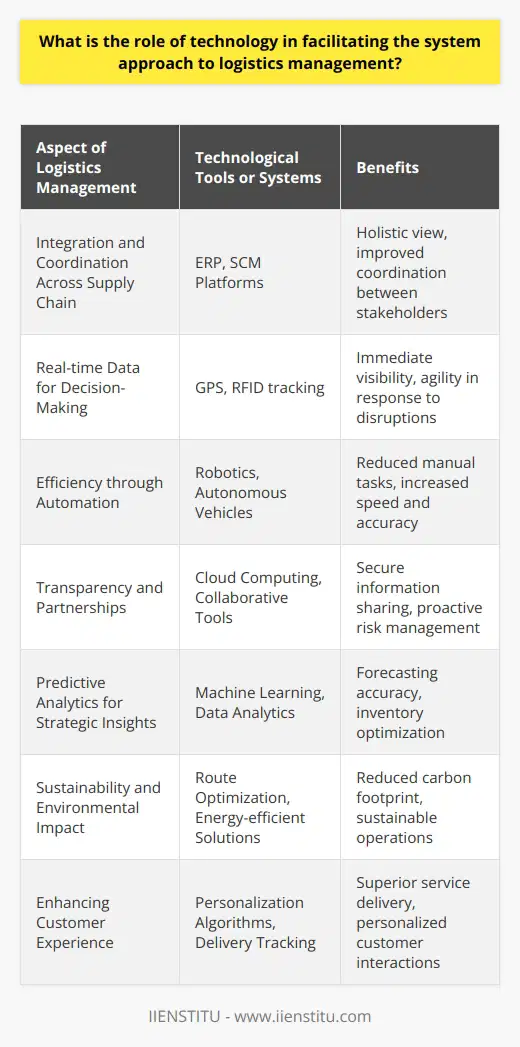
How does the implementation of routing and scheduling strategies impact the overall efficiency of logistics operations?
Effect on Efficiency
The implementation of routing and scheduling strategies directly affects the overall efficiency of logistics operations by optimizing resource allocation and minimizing operational costs. Effective routing and scheduling decrease total travel distances, fuel consumption, and delivery times, ultimately improving asset utilization and productivity levels.
Resource Allocation
Routing and scheduling strategies help in identifying the optimal combination of resources, such as vehicles, drivers, and warehouses, to fulfill the demand in a cost-effective manner. Optimizing resource allocation helps businesses to avoid unnecessary or redundant resources, thereby increasing efficiency and reducing operational expenses. In addition, proper allocation of resources ensures that delivery capacities are maximized, contributing to increased productivity levels and better supply chain management.
Operational Cost Reduction
Minimizing operational costs is essential to improve the profitability of logistics operations. By implementing optimal routing and scheduling strategies, organizations can effectively reduce expenses incurred due to extra travel, excess fuel consumption, and the prolonged use of the vehicles and drivers. Reduced costs directly translate to increased efficiency and overall performance of the logistics operations.
Reduced Delivery Time
Effective routing and scheduling can help reduce the delivery time for each shipment by minimizing the distances traveled and avoiding traffic congestions or other disruptions. Shorter delivery times enable organizations to improve customer satisfaction by meeting delivery expectations and strengthening their competitive advantage.
Asset Utilization
Optimal routing and scheduling lead to better utilization of vehicles and drivers, ensuring that businesses make the most of their available resources without the need for additional capital investments. Improved asset utilization rates contribute to increased efficiency and better overall financial performance of the logistics operations.
Environmental Impact
Lastly, incorporating routing and scheduling strategies results in a reduced environmental footprint of logistics operations. Combining routes and efficiently scheduling deliveries can minimize fuel consumption and subsequently reduce greenhouse gas emissions.
In conclusion, implementing routing and scheduling strategies is vital for enhancing the efficiency of logistics operations. By optimizing resource allocation, reducing operational costs, minimizing delivery times, and improving asset utilization, businesses can greatly enhance their overall productivity while simultaneously reducing their environmental impact.
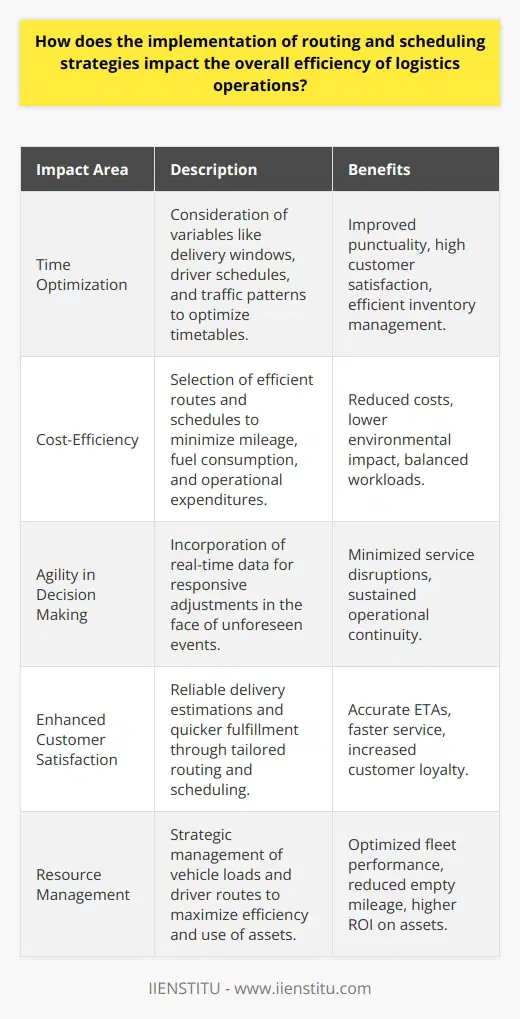
What is the relationship between various types of logistics systems and their impact on supply chain performance?
Logistics Systems Types
The relationship between various types of logistics systems and their impact on supply chain performance can be analyzed through specific systems, such as transportation, warehousing, and inventory management.
Transportation System Impact
Transportation systems play a crucial role in the supply chain as they enable the movement of goods between different nodes of the network. Effective transportation systems can improve cost efficiency, reduce delivery times, and enhance overall customer satisfaction. However, inefficient or unreliable transportation systems have the opposite effect, causing delays, increased costs, and decreased customer satisfaction.
Inventory Management Impact
Inventory management is closely linked to the overall performance of a supply chain. It ensures the availability of goods at the right time and place to meet customer demands. Effective inventory management reduces excess stock, minimizes stockouts, and minimizes the carrying costs of inventory. On the other hand, poor inventory management can lead to stockouts, which may result in lost sales opportunities or lead to increased carrying costs for excess inventory.
Warehousing System Impact
The warehousing system has a direct impact on the efficiency and overall performance of a supply chain. Efficient warehouse management can lead to cost savings through reduced labor costs, streamlined processes, and better space utilization. Furthermore, modern warehousing solutions such as automation and advanced technology can greatly enhance the speed and accuracy of order fulfillment. Conversely, poor warehousing practices can cause delays, errors, and increased labor costs, negatively impacting supply chain performance.
Interdependence and Coordination
The various logistics systems in a supply chain are also interdependent and require proper coordination to achieve optimal performance. For example, effective transportation management can increase the efficiency of inventory management by reducing the need for safety stock, thus lowering inventory costs. Similarly, levering technology and integrating warehouse systems with other logistics systems can promote end-to-end visibility, improving the overall responsiveness of the supply chain.
Conclusion
In conclusion, the relationship between various logistics systems and supply chain performance is a complex and interdependent one. The effectiveness of transportation, inventory management, and warehousing systems can directly impact the overall performance of a supply chain. Implementing proper coordination and investing in technology to integrate these systems can further enhance their positive impact on supply chain performance.
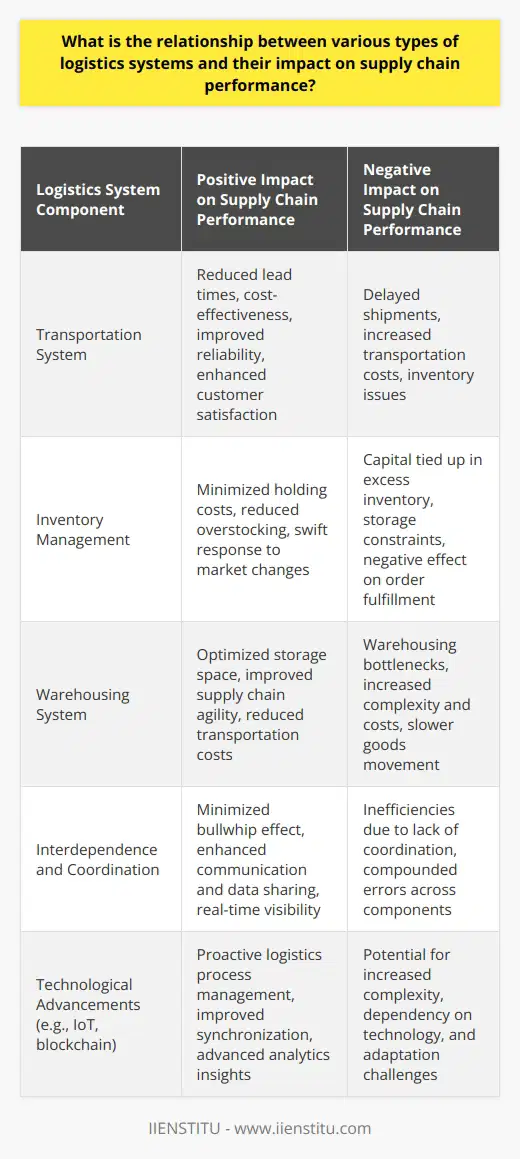
What are the key principles of the system approach in logistics management?
Key Principles of System Approach in Logistics Management
Holistic Perspective
The system approach in logistics management emphasizes the importance of a holistic perspective, considering all the components of a business as interconnected rather than viewing them in isolation. This allows for the effective coordination of individual elements to achieve overall organizational goals.
Integration of Processes
Adopting a system approach acknowledges that logistics management encompasses a wide range of processes such as procurement, transportation, warehousing, and distribution. By integrating these processes seamlessly, organizations can optimize their resources, reduce costs, and improve efficiency.
Decision Making through Analysis
System approach methodologies highlight the importance of data-driven decision making. Organizations collect and analyze pertinent data for accurate forecasting, informed decision-making, and continuous improvements in order to improve logistical performance and overall effectiveness.
Flexibility and Adaptability
One of the crucial principles of the system approach is being able to adjust and adapt to ever-changing business dynamics. Logistics managers must be capable of modifying processes, workflow, and resource allocation in response to fluctuations in market demands or unforeseen disruptions.
Continuous Improvement
An organization employing a system approach should consistently strive for continuous improvement within its logistical processes. This principle encourages organizations to assess and evaluate their existing systems and adopt recommended practices, technological advancements, and innovative strategies to remain competitive in the market.
Coordination and Collaboration
Effective logistics management thrives on coordination and collaboration among different stakeholders. The system approach fosters collaborative relationships with suppliers, customers, and other partners to ensure smooth communication and logistical operations throughout the supply chain.
Considering these key principles, the system approach in logistics management is essential to enhance the overall efficiency, cost-effectiveness, and competitiveness of an organization. By embracing a holistic perspective, integrating processes, making informed decisions, being adaptable, striving for continuous improvement, and fostering coordination and collaboration, organizations can successfully navigate the complexities of modern logistics.
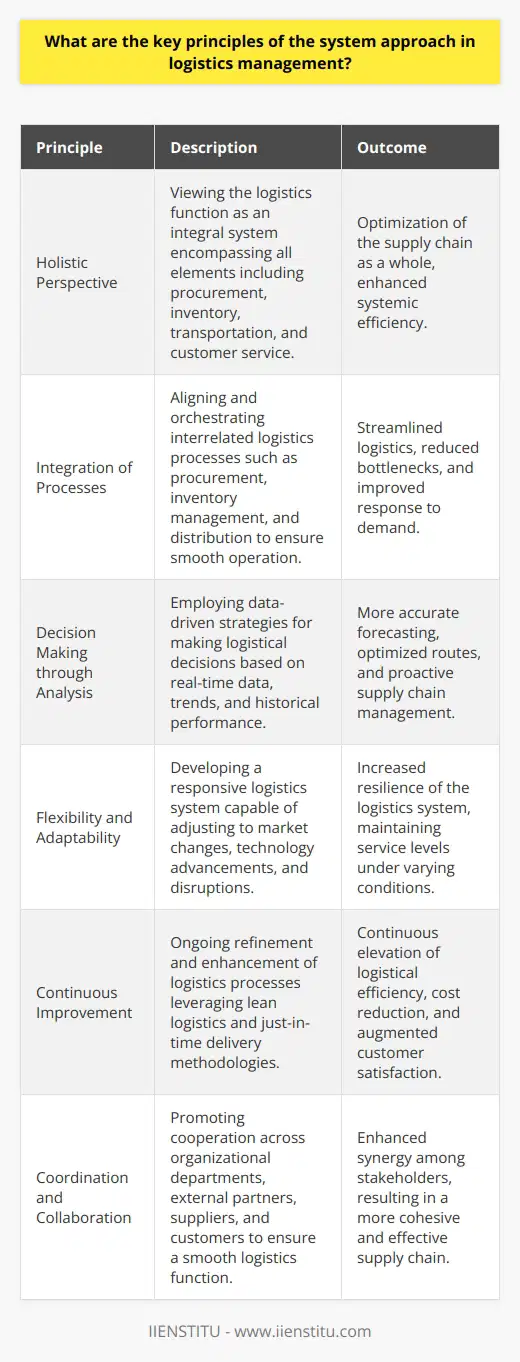
How do routing and scheduling techniques contribute to effective and efficient supply chain management?
**Routing Techniques in Supply Chain Management**
Routing techniques play a crucial role in supply chain management by determining the optimal paths for transporting goods from the point of origin to the destination. These techniques take into account several factors, such as distance, travel time, transportation costs, and customer demands, to ensure timely deliveries and minimize transportation expenses. By employing efficient routing techniques, businesses can reduce their operational costs, enhance customer satisfaction, and gain a competitive advantage in their respective industries.
**Scheduling Methods for Effective Supply Chain Operations**
Scheduling techniques, on the other hand, are vital for coordinating the various activities and resources involved in the supply chain. These methods ensure that the production, storage, and transportation phases align with one another, preventing delays and stockouts. Effective scheduling not only enhances the overall efficiency of the supply chain but also contributes to better collaboration among stakeholders, including suppliers, manufacturers, distributors, and retailers.
**Synergy of Routing and Scheduling in Supply Chain Management**
The combination of routing and scheduling techniques results in a more effective and efficient supply chain management system. By optimizing routes and streamlining schedules, businesses can effectively manage their resources, maximize their profits, and respond to market fluctuations in a timely manner. This synergy also reduces the potential for miscommunication, redundancy, and delays in the supply chain, which contributes to smoother operations and improved responsiveness to customer demands.
**Adaptation and Continuous Improvement in Supply Chain Management**
For a supply chain to remain efficient and effective, it is essential to constantly evaluate and adjust routing and scheduling techniques in response to changing market conditions, advances in technology, and evolving customer preferences. With the continuous improvement and adaptation of these methods, businesses can maintain their competitiveness and ensure their supply chains are consistently able to meet customer expectations while minimizing operational costs.
In conclusion, routing and scheduling techniques are critical components of an effective and efficient supply chain management system. By optimizing transportation routes, coordinating schedules, and continuously adapting to changes in the market, businesses can create a robust supply chain that leads to increased customer satisfaction, reduced costs, and improved overall operational efficiency.
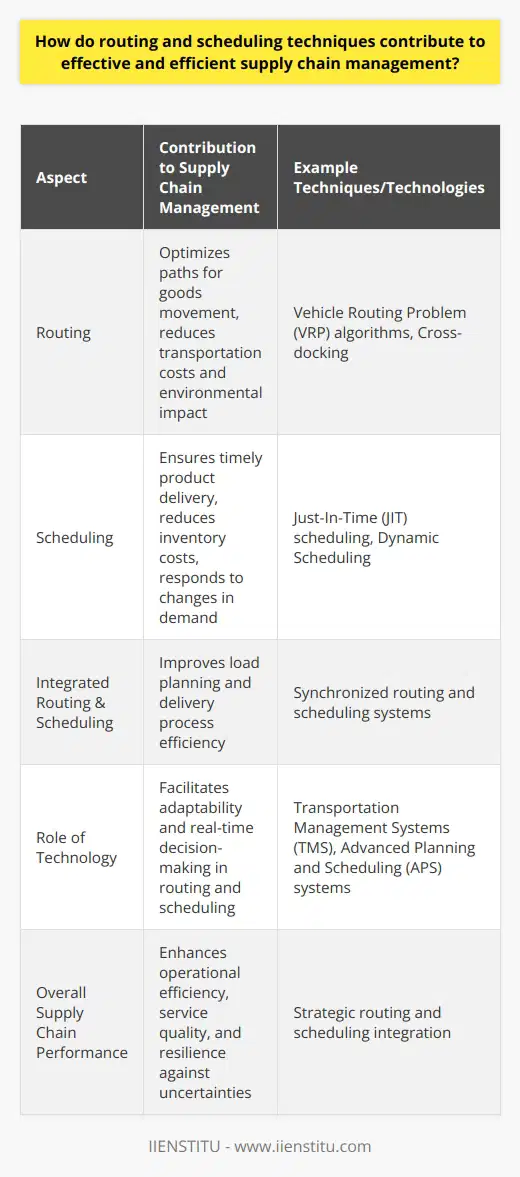
What are the main challenges faced by different types of logistics systems in addressing the dynamic needs of global supply chains?
Challenges in Conventional Logistics Systems
Conventional logistics systems face numerous challenges in addressing the dynamic needs of global supply chains. Firstly, the lack of flexibility and responsiveness in these systems creates difficulties in adapting to fluctuations in customer demands and market conditions. Additionally, conventional logistics systems often experience inefficiency due to the siloed nature of their organization, leading to increased transportation costs and longer lead times.
Obstacles in Technological Integration
Many logistics systems struggle with the integration of advanced technologies and digital platforms into their operations. Implementing data-driven solutions and automation requires significant investments in infrastructure, workforce training, and process reengineering. Furthermore, data security issues and the potential loss of control over sensitive information can hamper the adoption of digital technologies in logistics systems.
Coordination and Collaboration Difficulties
A key challenge in global logistics systems is to coordinate and collaborate with a diverse network of partners, such as suppliers, carriers, and customers. Achieving seamless information sharing and communication across different channels improves transparency and supports decision-making. However, varying capacities, technological capabilities, and cultural differences can hinder the establishment of successful collaboration.
Environmental and Social Concerns
Logistics systems must address the growing demand for sustainable and socially responsible practices in global supply chains. This entails reducing the environmental footprint of operations through optimizing transportation routes, using energy-efficient vehicles and technologies, and minimizing waste generation. Additionally, adopting ethical labor practices, enhancing workplace safety, and ensuring fair working conditions are increasingly crucial in the era of corporate social responsibility.
Geopolitical Risks
Global logistics systems are often subjected to geopolitical risks, such as trade disputes, economic sanctions, and political instability. These challenges can disrupt supply chain continuity, cause delays, and increase operational costs. Effective management of geopolitical risks requires a comprehensive understanding of the global business environment and agility in adjusting processes and strategies.
In conclusion, the main challenges faced by different types of logistics systems in addressing the dynamic needs of global supply chains include the limitations of conventional systems, technological integration obstacles, difficulties in coordination and collaboration, environmental and social concerns, and geopolitical risks. Overcoming these challenges necessitates implementing innovative solutions, adopting digital technologies, fostering collaboration, and prioritizing sustainability and resilience.
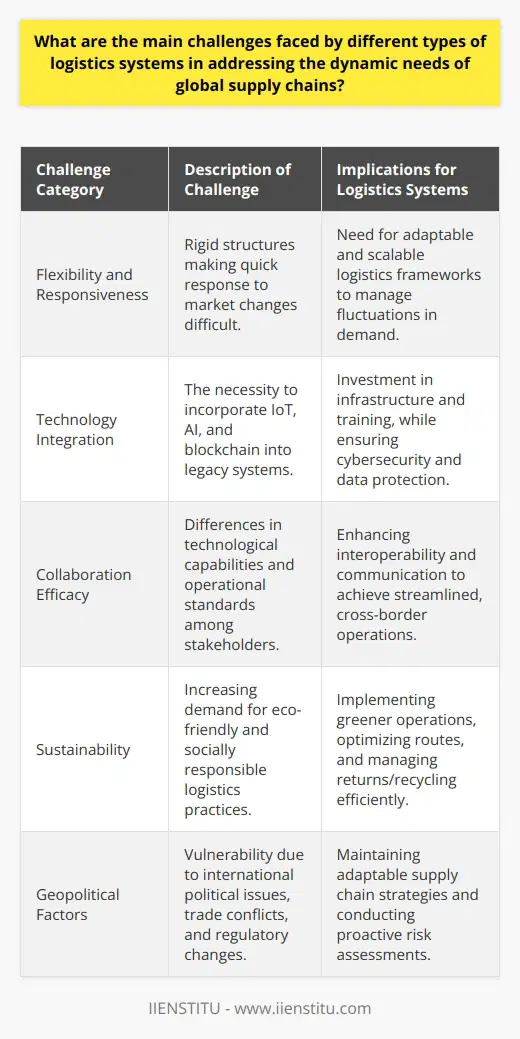
What are the methods of transportation in logistics?
Methods of Transportation in Logistics
Road Transport
One of the most common methods of transportation in logistics is road transport, which involves the use of trucks, vans, and other vehicles to move goods from one location to another. This mode of transportation provides flexibility in terms of routes and delivery times, making it suitable for both short-haul and long-haul operations.
Rail Transport
Rail transport is another important mode of transportation in logistics. Goods are transported via specialized freight trains, which can accommodate large volumes and handle a wide variety of cargo types. Rail transport offers cost efficiency for long distances and is environmentally friendly, as it produces lower emissions compared to road transport.
Air Transport
For time-sensitive deliveries and perishable goods, air transport is often the preferred method. This mode of transportation involves the use of airplanes to move goods quickly over long distances. Although air transport can be expensive, it offers reliability and speed that cannot be matched by other forms of transportation.
Sea Transport
Maritime transport plays a crucial role in global logistics, as it facilitates the movement of goods across continents via container ships and other specialized vessels. Sea transport is cost-effective for transporting large volumes of goods, particularly when considering the economies of scale. However, this method can be slower compared to other modes of transportation due to longer transit times.
Intermodal Transport
Intermodal transport combines two or more modes of transportation to efficiently move goods from origin to destination. For example, goods may be transported by rail to a port where they are then loaded onto a ship for further transport across the ocean. This method allows for the optimization of resources and increased flexibility when planning logistic operations.
In conclusion, the methods of transportation in logistics vary based on several factors such as distance, delivery time, cost, and cargo type. These transportation options include road, rail, air, sea, and intermodal transport. Each method offers unique advantages and disadvantages, and selecting the most appropriate mode of transportation is essential for businesses to optimize their logistics operations.
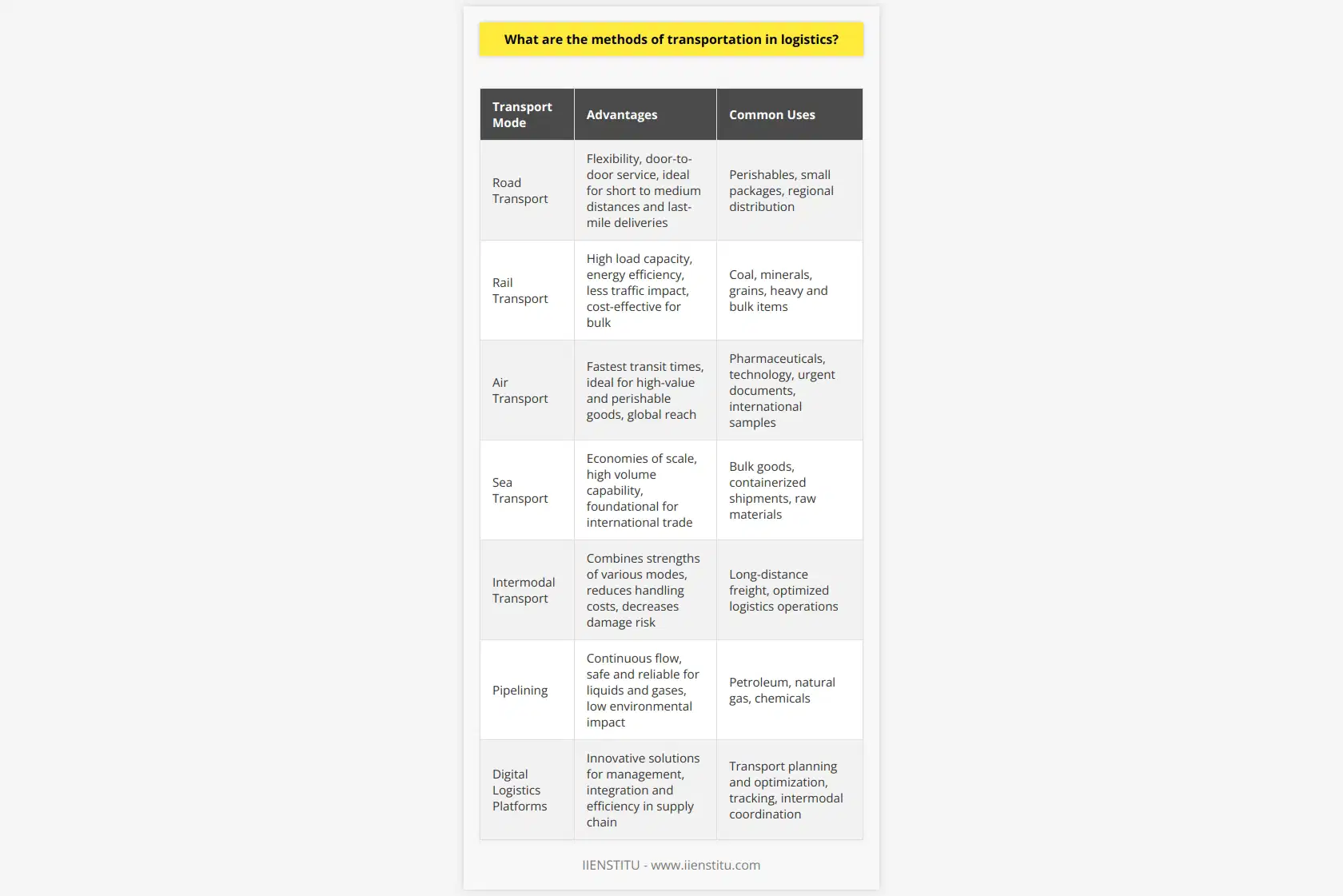
How can the systems approach in logistics management be used to enhance coordination and integration among various supply chain actors?
Enhancing Coordination and Integration
The systems approach in logistics management can be effectively employed to enhance coordination and integration among the various supply chain actors by undertaking a comprehensive analysis of the interdependencies among different components of the supply chain. By considering the supply chain as a whole, rather than as a series of fragmented or isolated processes, this approach allows for a better understanding of the complex relationships that exist between different supply chain components.
Identifying Interdependencies in the Supply Chain
A crucial aspect of this approach involves the identification and assessment of interdependencies among the different stages of a supply chain, such as procurement, production, and distribution processes. By understanding these relationships, logistics managers can develop integrated strategies to optimize the overall performance of the supply chain. Such strategies may involve collaboration and communication among various supply chain actors, leading to an increased level of trust and transparency.
Leveraging Technology for Improved Coordination
Moreover, the systems approach can drive innovation in the supply chain by promoting the use of advanced technologies and tools to improve coordination and integration. For instance, implementing sophisticated digital platforms and software applications can facilitate efficient information exchange and real-time decision-making. This technology-based intervention can ultimately lead to better inventory management, lower response times, and reduced lead times, thereby enhancing the overall effectiveness of the supply chain.
Fostering Cross-Functional Collaboration
In addition to analyzing the interdependencies within a supply chain, the systems approach also encourages cross-functional collaboration between actors engaged in the various components of the supply chain. By breaking down silos and promoting an environment of open communication, this approach sets the stage for greater problem-solving and continuous improvement initiatives. Consequently, such collaborative efforts help to prevent production disruptions, minimize the risk of supply shortages, and ensure the smooth delivery of products to end users.
Promoting Strategic Partnerships
The systems approach in logistics management can further contribute to the enhancement of coordination and integration through the formation of strategic partnerships between supply chain actors. By collaborating closely with suppliers, manufacturers, and transport service providers, logistics managers can develop a coordinated response to market changes and fluctuations in demand. These strategic partnerships can also play a crucial role in mitigating risks associated with disruptions and uncertainty in the supply chain.
In conclusion, leveraging the systems approach in logistics management can significantly improve coordination and integration among various supply chain actors. By identifying interdependencies, fostering collaboration, implementing advanced technologies, and fostering strategic partnerships, this approach can streamline operations and enhance the overall performance of the supply chain.
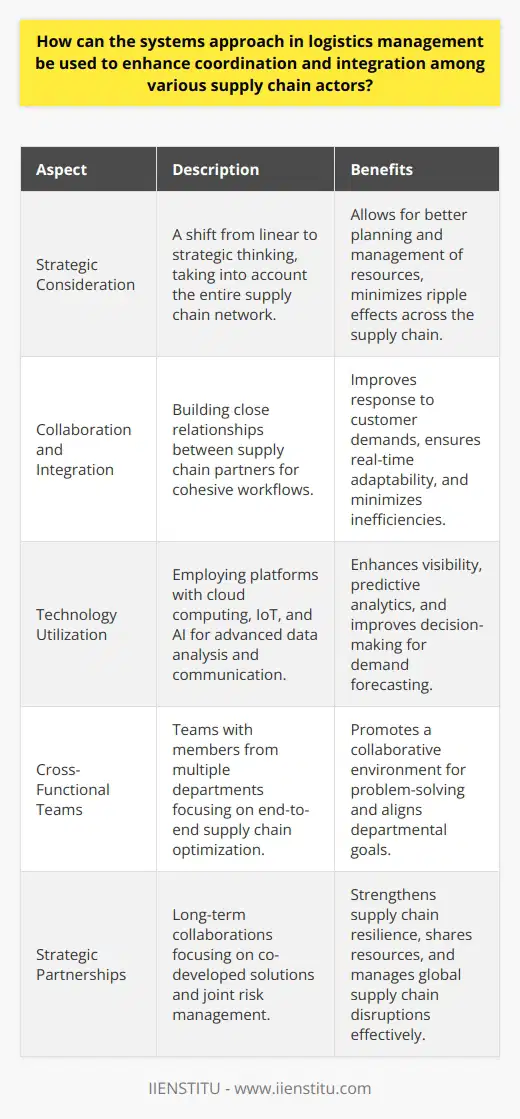
What are the key factors to consider when implementing routing and scheduling strategies in a logistics system?
Logistics System Considerations
When implementing routing and scheduling strategies in a logistics system, several key factors must be considered to maximize efficiency, minimize costs, and ensure timely delivery of goods and services.
Demand Variation and Forecasting
Logistics systems need to account for fluctuations in demand to avoid stockouts, backlogs, and excess inventory. By analyzing historical data and market trends, logistics managers can develop accurate demand forecasts and optimize the system to meet future requirements.
Geographical Constraints
Understanding geographical constraints is essential when choosing optimal routes for transportation. Managers should analyze the locations of warehouses, distribution centers, and customers relative to one another, factoring in distance, travel time, and access to transportation infrastructure, such as highways and ports.
Transportation Modal Choice
Selecting an appropriate transportation mode is crucial to the performance and cost-effectiveness of a logistics system. Decision-makers must evaluate various transportation methods like road, rail, air, and sea, considering factors like delivery speed, cost, and environmental impact.
Capacity and Resource Allocation
Allocating resources efficiently is a critical factor in logistics system performance. This includes managing warehouse capacity, ensuring vehicles do not exceed their weight limits, and effectively utilizing the available workforce. Managers must reliably predict resource requirements to make informed decisions on allocation and organization.
Flow Synchronization
Coordinating the flow of goods within the logistics system is necessary to ensure timely deliveries and minimize disruptions. Proper scheduling should be maintained for the loading and unloading of goods at different points in the supply chain, often requiring the synchronization of multiple parties.
Contingency Planning
Unexpected events, such as vehicle breakdowns, road closures, or inclement weather, can hinder the performance of logistics systems. Developing contingency plans and alternative routes ensures the continued operation of the system during disruptions, reducing the risk of service failures and customer dissatisfaction.
Information Technology and Systems Integration
Implementing advanced information technology systems, such as fleet management software and GPS navigation, can have a significant impact on the efficiency of routing and scheduling strategies. Integrating these technologies streamlines operations, allowing data-driven decisions that improve the overall performance of the logistics system.
In conclusion, it is essential to consider various factors such as demand forecasting, geographic constraints, transportation choices, resource allocation, flow synchronization, and contingency planning when implementing routing and scheduling strategies. Additionally, leveraging information technology and systems integration can contribute to improving overall logistics performance and fulfilling customer requirements.
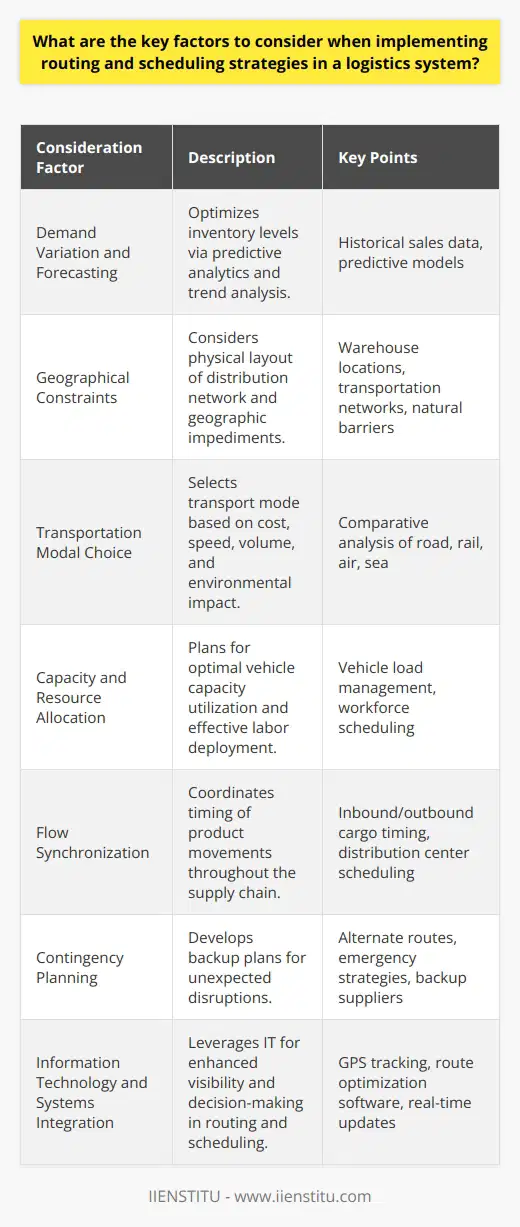
What are the critical components of a systems approach in logistics management?
System Components
The critical components of a systems approach in logistics management include planning, organizing, and controlling. Such a system organically aligns with the broader objectives of the organization.
Planning Component
Planning plays an essential role in logistics management. This element ensures efficiency and effectiveness in operations. Logistics managers create logistics strategy and tactical plans to align with the overall business goals. They plan demand and supply, manage inventories, forecast future logistics requirements and design a logistics system that matches these requirements.
Organizing Component
In logistics management, organizing is another critical component. It entails the delegation of tasks, authority, and resources to ensure efficient execution of plans. Managers establish responsibilities for each logistics operation, organize resources, define roles and duties, and arrange the workforce systematically. This effort ensures that individual tasks align with the broader logistics strategy.
Controlling Component
The controlling component ensures that the plans are proceeding as per the set standards. Regular monitoring and reporting on logistics performance are crucial. Managers evaluate performance, compare outcomes with goals, and correct deviations. Timely feedback and corrective actions are integral for the controlling function to be effective.
In conclusion, a systems approach in logistics management involves critical components: planning, organizing, and controlling components. These elements ensure the logistics operations are efficient, effective, and aligned with the organization's objectives. These pillars of logistics operations are interdependent, necessitating integration for the effective management of logistics.
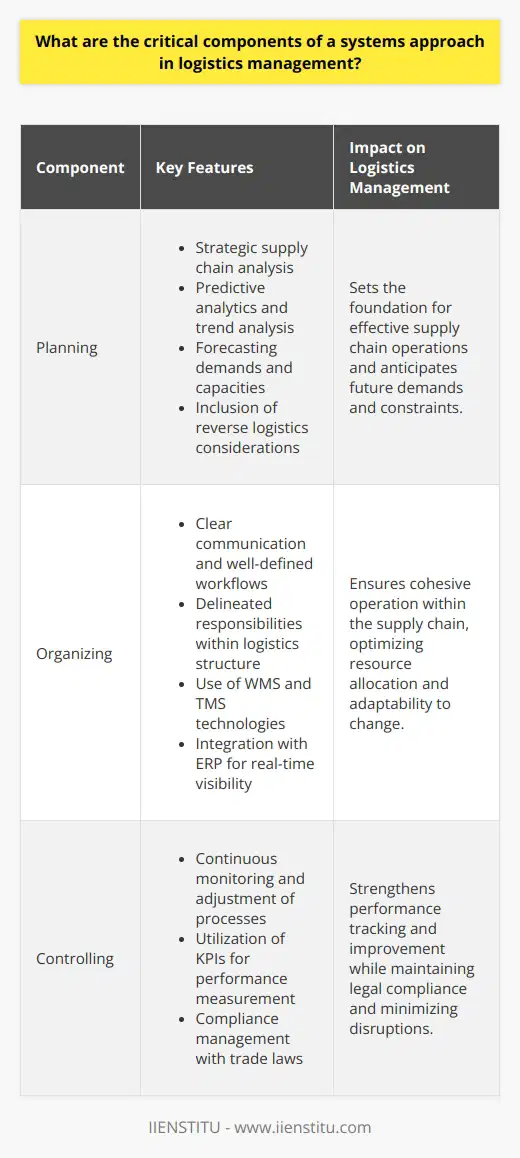
How can organizations effectively adapt routing and scheduling strategies to address changing market demands?
Optimizing Logistics with Demand Fluctuations
Organizations can effectively adapt routing and scheduling strategies to address changing market demands. The first step towards adaptation is through the incorporation of advanced technology. High-quality forecasting software harnesses historical data, providing valuable insight on varying demand patterns.
Utilizing Predictive Analytics
Effective use of predictive analytics can enable organizations to anticipate consumer needs. By recognizing trends, organizations can make informed decisions about routing and scheduling, ensuring that resources focus on high-demand areas. Furthermore, regular review and adjustment of these patterns in line with market demands improve efficiency.
Adopting Flexible Strategies
The adoption of flexible routing and scheduling strategies is essential. Modular strategies can adapt to market fluctuations, channeling resources where needed. Flexibility allows organizations to respond more rapidly to changing dynamics, avoiding wasted resources or missed opportunities.
Advancing Transport Operations
Investment in advanced transport management systems (TMS) is beneficial. A robust TMS provides real-time visibility over operations, facilitating rapid response to changes. GPS and Internet of Things (IoT) technologies can provide invaluable data, streamlining routing and scheduling procedures effectively.
Promoting Efficient Communication
Communication also plays a key role in market-driven adaptation. By ensuring open lines of communication between logistics, production and sales teams, organizations can have a holistic view of market demands. This approach results in more effective scheduling, better anticipation of demand and lessened waste.
In summary, effective adaptation to changing market demands requires advanced technology, predictive analytics, flexible strategies, investment in TMS and efficient communication. These measures facilitate improved routing and scheduling strategies, leading to efficient operations that keep pace with shifting market dynamics.
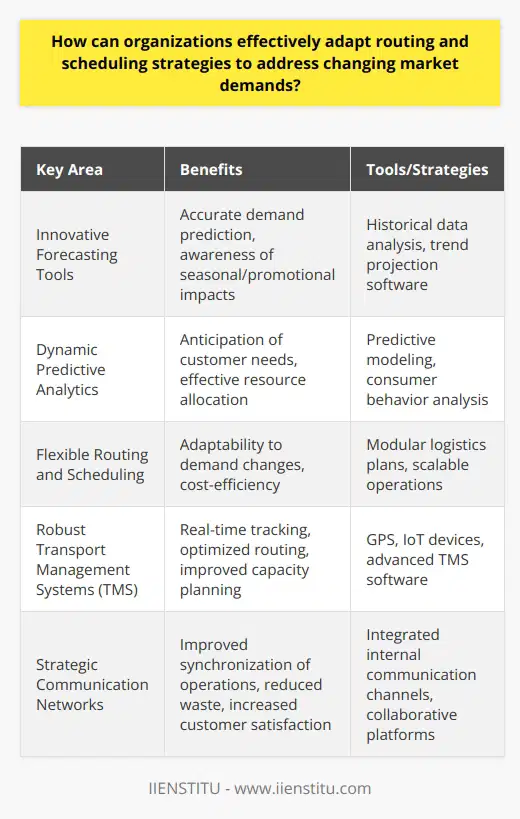
What role do the 7 R's of logistics management play in creating a resilient and adaptive logistics system?
Understanding Roles of the 7 R's in Logistics Management
The seven R's of logistics management play a pivotal role in creating a resilient and adaptive system. They involve getting the Right product, in the Right quantity, in the Right condition, at the Right place, at the Right time, to the Right customer, at the Right price.
Significance of Right Product and Quantity
The first two R's, Right product and Right quantity, ensure inventory optimization. They help companies avoid excess stock and stock-outs, which can hinder operation efficiency.
Importance of Right Condition and Place
Next, the Right condition and Right place maintain the product's quality during transportation. This helps companies meet customer standards and preserve a positive business reputation.
Relevance of Right Time and Customer
Ensuring the Right time and Right customer guarantees timely and accurate delivery. This increases customer satisfaction and builds trust, which can result in repeat business.
Role of Right Price
Lastly, offering the Right price is crucial. This means the total cost, including the cost of the product and its transportation, should be economical for both the company and the customer.
Collectively, the 7 R's act as guiding principles for effective logistics management. They enable companies to adapt to changes in market conditions and consumer demands. They also empower companies to continuously improve their operations and customer service, thereby creating a more resilient system. Ultimately, adhering to these principles allows for an overall improvement in the competitiveness and profitability of the business.
